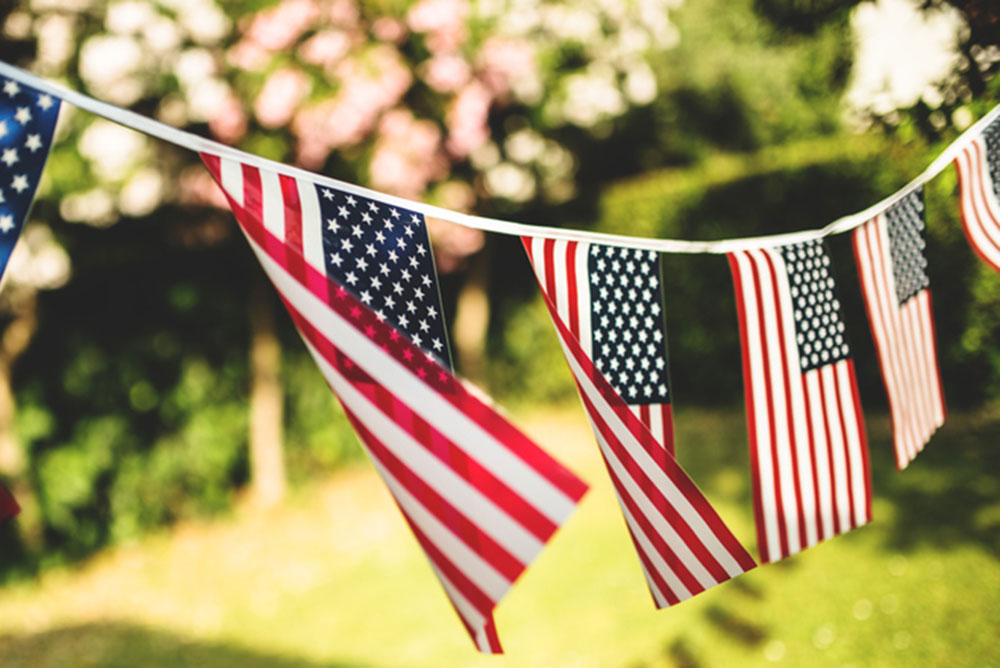
iStock
LET’S CELEBRATE our democracy. Here’s to the red, white and blue —and families, friends getting together again!

iStock
LET’S CELEBRATE our democracy. Here’s to the red, white and blue —and families, friends getting together again!
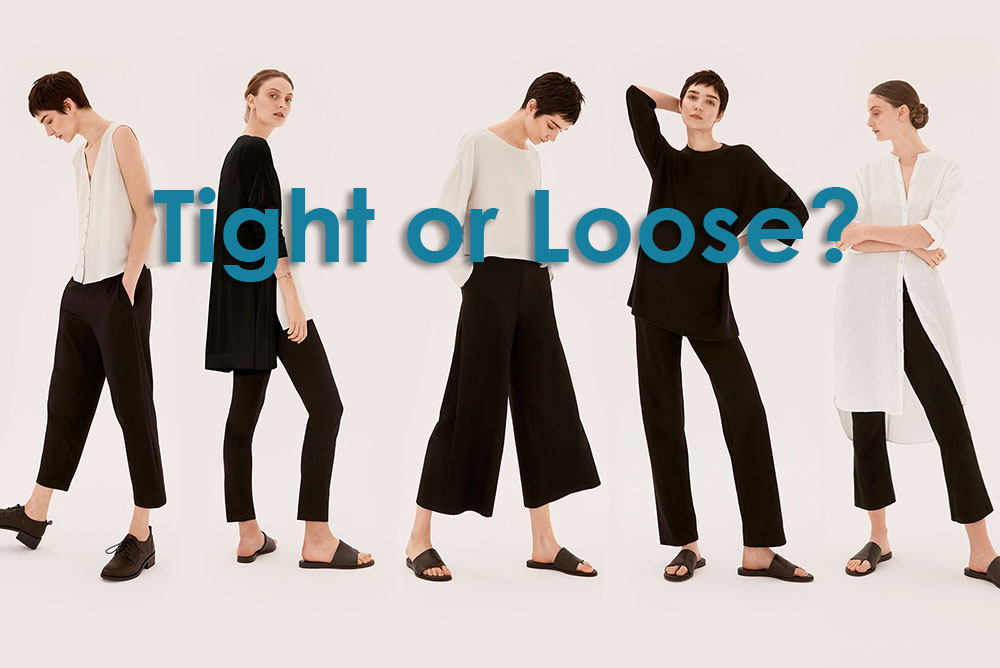
By MyLittleBird Staff
IT’S JULY—tomorrow—but September’s on my mind. Over the next couple of months many of us will be returning to offices, volunteer work, in-person meetings, lunches and dinners inside restaurants, our so-called pre-Covid “normal” lives.
Which is why last week we asked readers how they envision themselves in their post-pandemic lives. How will your wardrobe change? What are your thoughts about “back-to-school” clothes?
Thanks for taking the time to answer. We received a range of opinions/responses, including a couple of diametrically opposed ones—one recently retired Washington Post editor was certain she was going to kiss snug clothing goodbye forever, while an Allegheny Court judge was equally positive that her post-Covid wardrobe of pants and jackets would be form-fitting. A few of you were looking forward to dressing up again, even wearing sparkly jewelry, while others were confident that their dress would remain on the casual side but with a healthy dose of “chic.”
But we’ll let you speak for yourselves. Here’s what you told us:
Cindy Skrzycki, senior lecturer emerita, nonfiction writing, University of Pittsburgh:
Nothing from my previous life fits me, nor would I want to wear it. As my mom used to say, it’s the spread.
Caren Sniderman, former assistant city editor at The Pittsburgh Press:
My lifestyle has not changed much. Except for going out to lunch/dinner, my activities stayed the same. Now, my old going-out clothes seem like new after a rest in my closet.
Christine Ledbetter, former arts editor, Washington Post, now freelance writer:
I will never again buy snug. No more tight jeans, underwire bras, unforgiving waistbands. Post pandemic I’m buying a travel wardrobe for all the trips I missed last year. Also, I never wore sneakers before unless it was for working out but I’m loving some of the upscale looks by Rag & Bone, Fendi and Stuart Weitzman. I want to breeze through airports in chic comfort.
Linda Kastan, arty museum guide, New York City:
Casual chic. For example: Looser pants (beige or black); solid top (e.g., black top with beige pants), khaki suede sneakers, silver necklace. I’ve been buying Missoni sweaters (0n sale) to wear as tops for going out to dinner.
Maureen Young, former director, government relations at Carnegie Mellon:
Because I have a new(ish) boyfriend, I have been wearing nice clothes all along — linen dresses, good slacks and blouses, etc., regardless of Covid.
Cathy Bubash, judge on the Allegheny County Court of Common Pleas in Pennsylvania:
I’ll wear the same thing I always did— uniform of pants and jackets with various tops and pumps, all of which will be “tight.”
Nancy Gold, retired divorce and family law attorney:
Because I really retired effective January 1 this year, I’m not going back to an office. However, I am out in the community more and find myself actually “getting dressed” to go out. After living in sweats and jeans for over a year, it’s a pleasure to think about what’s in my drawers and closet and devising new combinations and outfits with what’s there. And there’s a lot there! So, I wear one of my many pairs of beautiful black trousers, with a colorful top (not a T-shirt), and real sandals now, not flip-flops. I’ve even switched out my handbag to one a little more structured. To me, it’s true that when you really get dressed you move and behave with a bit more “class.”
Bonnie Casper, Long & Foster real estate agent:
I actually have been thinking about this. I think I have been wearing more pants, although I was always primarily a dress/skirt person. But, at least for the spring and summer, my wardrobe is “less formal,” while still business appropriate. I also have been wearing a few summer dresses but not predominantly. (To be honest, many meetings are still Zoom, although I have to get out to meet with clients, etc.). I do not know how I will feel come fall and winter. It seems as if styles changed over the last 14 months but not sure how or what is “current.”
Judith Robinson, poet and painter:
Well, Little Bird, my immediate future will probably actually involve a bit more socializing as I don’t “work” out in the world. So I like the idea of dressing up a little, maybe some colorful summer prints and some sparkly jewelry. Feels like fun times coming!
Mary Falvello, medical billing specialist:
My work is dress casual. I have gone back to basics in my style—skinny straight-leg pants and a simple T-shirt or sweater and a cardigan or jacket. Also been wearing more blouses. I have never worn leggings. I find that wide legs and baggy tops are not my best look.
It will be nice to wear a little heel again and some of my sandals. I used to have fun changing up necklaces, but for the past year I’ve worn this little diamond necklace, and I’ve kind of gotten used to the look. Looking forward to putting on lipstick and taking more time with my hair. The masks sure concealed a lot of flaws.
P.S. If you let your hair go gray, are you going to dye it again? Will you have manicures again or let your nails go au naturel? I know we didn’t specifically ask these questions in the first place, but if you’d like to respond, send me an email: janet@mylittlebird.com. Thanks.
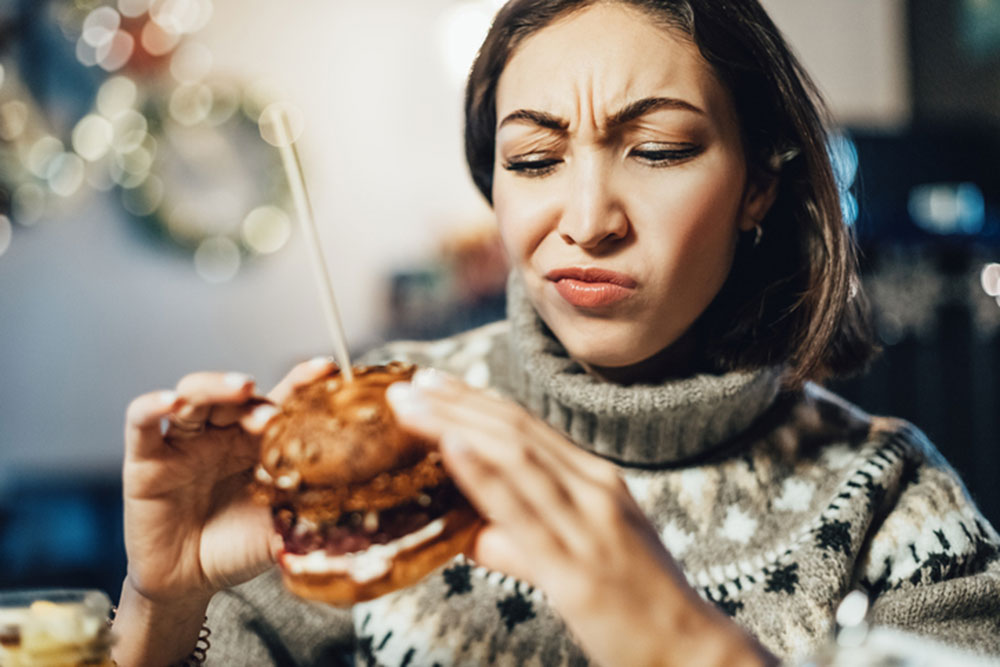
iStock
By Andrea Rouda
FOR LUNCH today I phoned in an order to a cafe that was on the way home from an early appointment. It was a simple order, just a veggie wrap (lettuce, tomatoes, cucumber, black olives and hummus) and a black coffee. The person on the phone said it would be ready in 20 minutes.
I arrived at the shop and went inside to pick up my order, which was not yet ready. The scene behind the counter was frightening: Several staffers were answering phones, making sandwiches, bagging orders and bumping into one another with the precision of a group of Ringling Brothers circus bears learning how to tap dance. Someone looked up at me and shouted, “Stand back! Wait over there, we’ll call your name when it’s ready.”
Finally it was, and I was happy to escape the chaos. I drove home, eager to eat my tasty sandwich. Only when I opened it turned out to not be my sandwich but someone else’s. This one had chunks of chicken breast and sun-dried tomatoes and some sort of secret sauce I could not identify. Annoyed but hungry I ate it anyway, not wanting to drive the six miles back and wait another 20 minutes for it to be made right. (I bet the carnivore who got my sandwich was more disappointed.)
Anyway, what’s wrong with people these days? On my car radio I heard a talk show host marvel at the fact that, “We’ve come so far in the 66 years since the first flight of the Wright Brothers at Kitty Hawk.” I thought that sounded wrong, since that would mean that flight was invented when I was nine, and I knew that wasn’t so. When I got home I checked online and learned the correct date of the first flight was December 17, 1903, or 118 years ago.
There’s no punchline. But maybe Covid isn’t the only scary thing going on these days.
—Andrea Rouda
Andrea Rouda blogs at The Daily Droid.
By Janet Kelly
All photos from gallery above are courtesy of the American Federation of Arts.
SUMMERTIME 2021, and museums from Paris to Pittsburgh are welcoming visitors again.
Should you fancy a road trip on the East Coast rather than a transatlantic flight, make tracks to Pittsburgh, where the Frick museum continues its tradition of mounting fashion-focused exhibits (e.g., “Killer Heels: The Art of the High-Heeled Shoe,” “Undressed: A History of Underwear” and “Paper Couture: The Art of Isabelle de Borchrave“) with “Sporting Fashion: Outdoor Girls 1800 to 1960.”
Opening July 3, the exhibit will explain how new technologies and changing social mores influenced women’s clothing and how the basics of women’s sportswear today—from swimsuits to sneakers—were designed during a time when women were achieving more freedom.
A 350-page catalogue by curators Kevin L. Jones and Christina M. Johnson, with a preface by Serena Williams, accompanies the exhibit. Williams, who memorably wore a catsuit to the 2018 French Open, writes, “I have pushed the boundaries of what is acceptable for women to do, to be and to wear it sport… “Appreciate the courage and daring of all those women who refused to be confined to the home and insisted on enjoying life in so many ways historically reserved for men.”
Sixty-four head-to-toe ensembles comprised of more than 480 historic objects from the collections of the FIDM Museum at the Fashion Institute of Design & Merchandising in Los Angeles—will feature clothing women wore to participate in activities (including promenading, tennis, horseback riding, camping, cycling, swimming, skiing, skating, flying and driving and illustrate how their clothing related to fashion, function and propriety.
Pieces from well-known sportswear brands that still exist include Keds, Spalding, Jantzen and Pendleton, as well as high-fashion garments from Balenciaga, Chanel, Patou and Pucci.
Among the exhibit’s many highlights are a 1920s beach promenading ensemble—a Jean Patou sweater and wool jersey sailor pants. “A woman could be on the beach or boardwalk wearing them, but by evening she would be arrested if she weren’t wearing a skirted outfit,” according to Jones. A must-see is a cabine de déshabillage, or a personal beach-changing tent, held up by a steel hoop, from late-19th-century France.
From Pittsburgh, the exhibition’s first stop on a three-year tour, the show will travel to Memphis, Tennessee; Davenport, Iowa; Utica, New York; Cincinnati, Ohio; Jacksonville, Florida and Los Angeles in fall 2024.
Sporting Fashion: Outdoor Girls 1800-1960
Dates: July 3, 2021 – Sept. 26, 2021
Hours: Tuesday through Sunday, 10am to 5pm
Location: The Frick Museum Pittsburgh, 7227 Reynolds St., Pittsburgh, PA 15208
Admission:
Members: Free
Adults: $15
Seniors/Students: $13
Youth 6–16: $8
Youth 5 and under: Free
Timed tickets are required for entry to the exhibition. Purchase online at The Frick or call 412-371-0600.
This exhibition is organized by the American Federation of Arts and the FIDM Museum at the Fashion Institute of Design & Merchandising, Los Angeles.
Support for the national tour is provided by the AFA’s Gold Medal Circle: Elizabeth Belfer, Stephanie Borynack Clark, Ashleigh Fernandez, Lee White Galvis, Stephanie R. La Nasa, Merrill Mahan, Clare E. McKeon, Jennifer New, Angela Timashev, and Victoria Ershova Triplett.

Clockwise, from left to right: Anya Hindmarch Eyes tote, Banana Republic clutch, Hat Attack’s fringed top handle bag and Sensi Studio’s crafty tote.
WEARING A woven bag when the weather warms is practically a rite of summer. And, this season, there are more options than ever—from clutches to cross-bodies to totes and top-handles in neutrals as well as bright colors and pretty patterns. Here, ones on my radar.
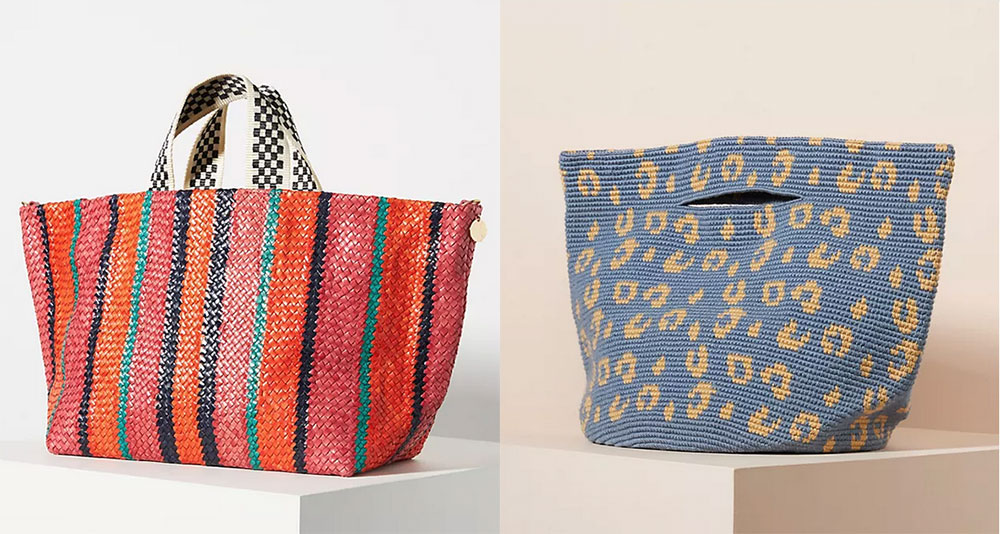
LEFT: Instead of red, white and blue, how about this cheery color combination—pink, poppy, navy and mint, offset with a checkered top handle? Clare V.’s Bateau Woven Tote ($475, Anthropologie) is a sturdy carryall with plenty of space (18 inches wide by 10 inches high by 6 inches deep) for your farmer’s market haul or your day-at-the-beach essentials. Plus, there’s an interior clasp and d-ring to cinch the bag into a different shape.
RIGHT: Designer Soraya Hennessy works with Venezuelan women artisans who handcraft accessories in fashionable patterns, such as this 13-inch-high-by-17-inch-wide by 4-inch-deep Leopard Crochet Tote Bag ($350, Anthropologie).

LEFT: Okay, I’ve had my eye on Anya Hindmarch’s Eyes Small Basket Bag Seagrass-Woven Basket Bag (pictured) for a while. Too long, I guess, because it’s sold out. Alternatively, the Eyes Large Basket Bag ($675, Matches), which is 24 inches wide and almost 12 inches high, is still available and just as darn cute.
RIGHT: The beauty of a clutch is you can’t stuff too much into it before it bulges and looks unattractive. When the occasion calls for only carrying a lip balm, mobile phone, credit card and a just-in-case mask, I’d slip this foldover, zip-top Mar Y Sol/Tula Clutch under my arm and be off. Handmade in Madagascar, it’s 100% raffia and sells for $130 at Banana Republic.

LEFT: Sequins and raffia make an unexpected but glamorous pairing on this medium-size (11.8 inches high by 16.5 inches wide and 5.9 inches deep) tote from Vanessa Bruno. It’s $290 at SP24.
CENTER: The fringe on the side gives Hat Attack’s tortoise-handle fringe bag ($134, Tuckernuck) its charm. It’s sold out on the Hat Attack and Shopbop sites, so if you like it, waste no time.
RIGHT: Founded by her grandmother in 1925, Caterina Bertini gave the Florentine accessories label a fresh new stamp when she took over the helm and expanded from straw hats to handbags. Lined in nylon with an inner zip pocket, the 10-inch high and 10-inch wide Colorblocked Raffia Tote Bag ($178, Anthropologie) comes with a 30-inch crossbody strap.
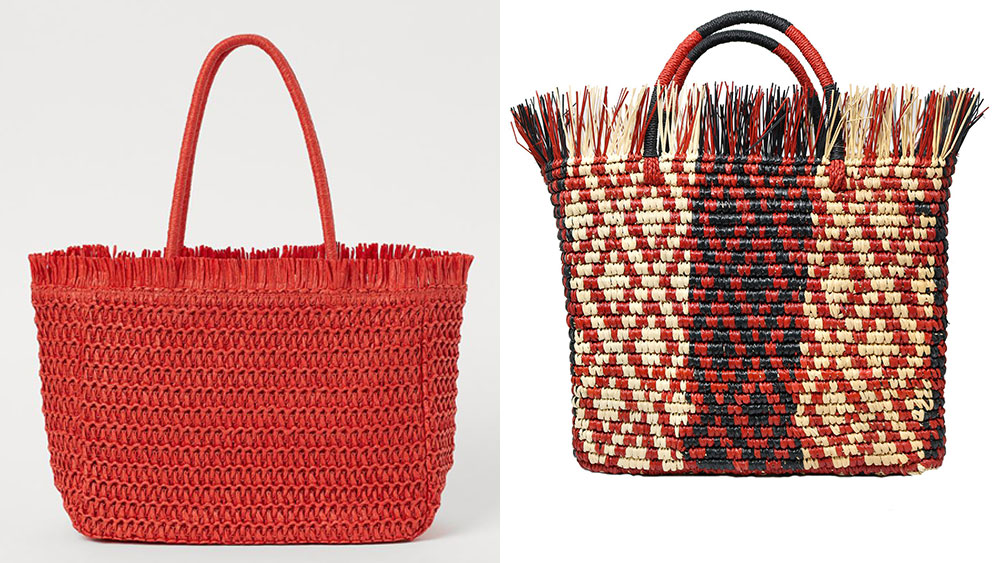
LEFT: Wouldn’t this square-shaped, braided paper straw Shopper ($24.99, H&M) with a fringe top edge and two handles look just splendid worn with a white eyelet summer dress?
RIGHT: If you fancy one of these handmade Canasta Mexicana totes, be prepared to wait between two to three weeks, the time it takes to complete one. Woven of the same toquilla straw used to make the finest— and most expensive–Panama hats, it is $276 at Sensi Studio.
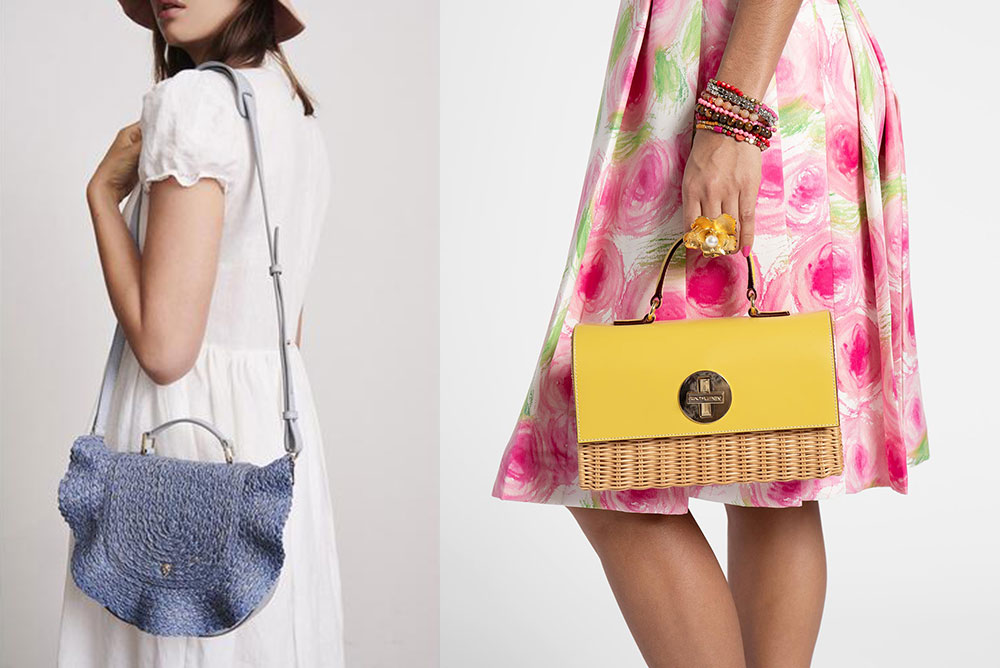
LEFT: I’m a long-time fan of Helen Kaminksi hats and bags. Kaminksi launched the brand in 1983 with hats she designed to protect her children from the searing Australian sun. In 1990, she expanded to bags with a raffia “sac” that I kept for many years until I wore it to a cigar party in D.C. and could never get the smoke smell out. The brand has new owners, but the emphasis on design remains, as do the high prices. The Madelyn Saddle Bag ($400), a mix of raffia and leather in a scallop shape, comes with a detachable leather shoulder strap and protective studs at the base of the bag. My personal peeve: most handbags, even very expensive ones, don’t have them.
RIGHT: Refresh your summer staples with a sunny silhouette. Made of wicker and vachetta (untreated leather designed to age), the Bess Wicker Basket ($298) from Frances Valentine—a modern take on the ladies-who-lunch bag—also has a detachable, adjustable crossbody strap. The peony-and-tulip printed cotton lining is a sweet throwback.
MyLittleBird often includes links to products we write about. Our editorial choices are made independently; nonetheless, a purchase made through such a link can sometimes result in MyLittleBird receiving a commission on the sale. We are also an Amazon Associate.
By MyLittleBird Staff
YIKES, FATHER’S DAY kind of sneaked up on us this year. Wasn’t it just Mother’s Day? The clock may be ticking but we haven’t forgotten our dear dads. We know it may be tricky to find something they really want (mainly because if they wanted it, they already bought it for themselves). However, we’ve unearthed a few things they may have overlooked. So, whether it’s your husband, brother, son or your own father, here are nine ways we’ve got you covered.
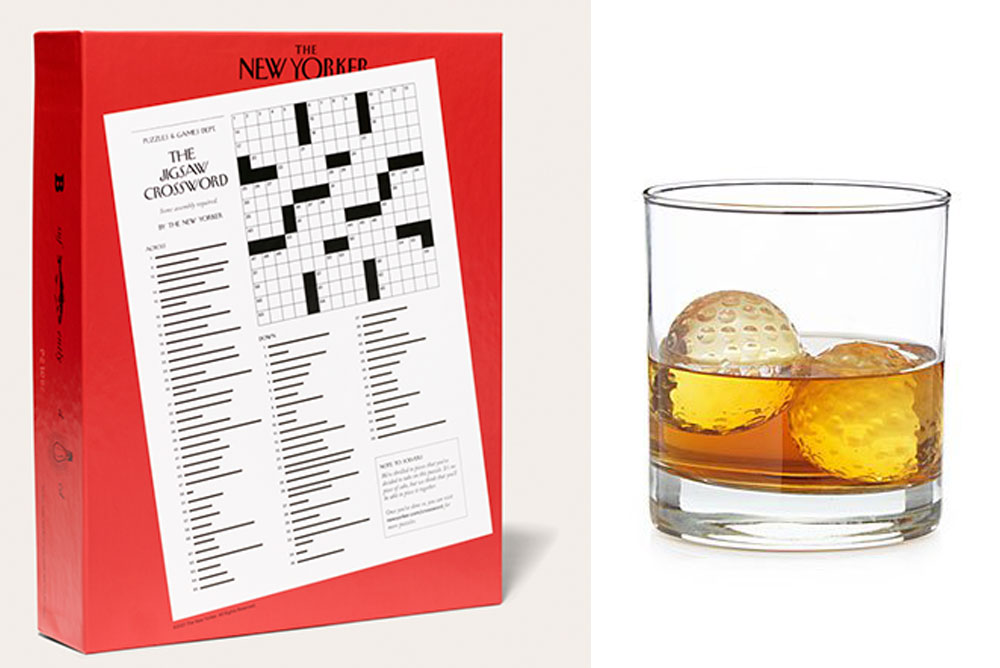
LEFT: If you don’t associate The New Yorker with crossword puzzles, you haven’t been paying attention (ahem). Since 2018, the weekly mag has been posting a Monday offering online and now has come up with a perfect Father’s Day gift for a puzzle-junkie dad. In fact, it’s a double puzzle: a jigsaw puzzle he has to put together before he can even tackle the crossword puzzle it will reveal. And he gets to solve said puzzle with an official New Yorker pencil, so there. The 500-piece NYer Crossword-Puzzle Puzzle is $35 at the magazine’s own online shop.
RIGHT: Your golfing dad probably has a set or three of golf-ball-shaped ice cube forms, but we bet he doesn’t have these. Unlike real ice cubes, these don’t melt. You put Uncommon Goods’s glass Golf Ball Whiskey Chillers ($30 for two) in the freezer for a few hours before pouring a shot of Scotch over them. Almost as good as a double eagle.
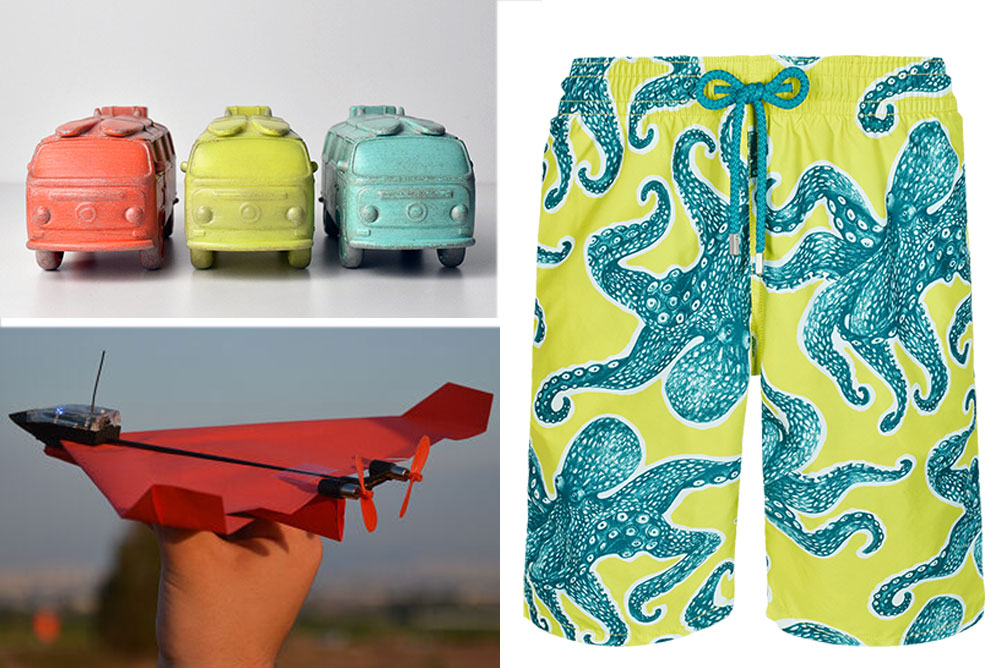
TOP LEFT: Combining computer technology with hand craftsmanship, the Brooklyn-based Locknesters design studio makes 3D puzzles that are a joy to look at and to handle (especially during boring conference calls). The Bus in particular is an object of youthful longing. Locknesters promises that each bus is computer-designed, then 3D-printed from American plastic (no toxic chemicals), hand-sanded, barrel-tumbled and hand-lacquered. The 8½-inch-long Bus is a five-piece puzzle and $60; the 6½-inch long Buddy Bus is $45 and breaks down to three pieces. Both sizes come in mint, orange or yellow.
BOTTOM LEFT: Janet’s dad used to take her brother and her to watch the airplanes take off at Kennedy Airport. They were not nearly as excited about the outing as he was. Today, he might have gotten some of the same thrill from showing them how deftly he could fly this Smartphone-Controlled Paper Airplane ($70, Uncommon Goods). Using one of the four included templates, you just fold the “paper” (crash-proof carbon fiber), attach the Bluetooth®-enabled device, download the app on your phone, and it’s off into the wild blue skies—for a 10-minute flight within a 230-foot range. You can ratchet up to the Flight Manual Bundle ($100), which includes 10 paper airplane templates with five different designs, two waterproof paper airplane templates and a detailed instruction guide.
RIGHT: Started in St. Tropez with a fun and colorful spirit, Vilebrequin is celebrating its 50th anniversary by bringing back a collection of 50 prints—one for each year from 1971 to 2021. These Swim Trunks ($290) are a 2014 Poulpes motif. Who wouldn’t want to pay almost 300 bucks to see their dad’s/husband’s legs crawling with octopuses and squid? To justify the expense: Your guy can team these long-cut swim shorts with a yellow polo shirt and be ready for cocktails sur la plage.
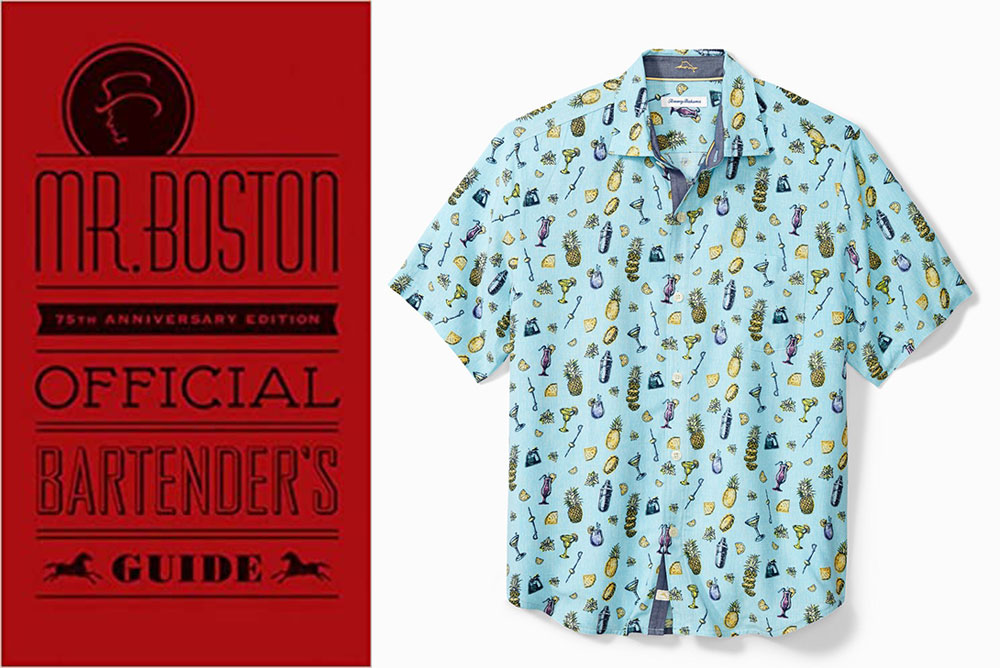
LEFT: Our friend Don has a well-stocked home bar, but when we asked him to make a French 75, he was stumped until he proudly pulled out his copy of Mr. Boston Official Bartender Guide ($52.88, hardback). The drink-mixing guide has been around since 1935. The up-to-date new edition—its 66th printing—includes more than 1,400 recipes, from classic cocktails to today’s trendiest drinks, along with advice on equipment and bar setup. Cheers, Dad.
RIGHT: Art Director Kathy Legg’s husband likes Tommy Bahama shirts. She likes them, too—on him—and recently bought him two. If you’re inclined to buy one of these beach-ready tops, one caveat: So people don’t think your dad is a fascist Boogaloo Boy, advise him to wear this tropical Mixer Camp Shirt ($118) or the Paradise Plumeria Island Zone Camp Shirt for $138 (not pictured) with a Pride pin.
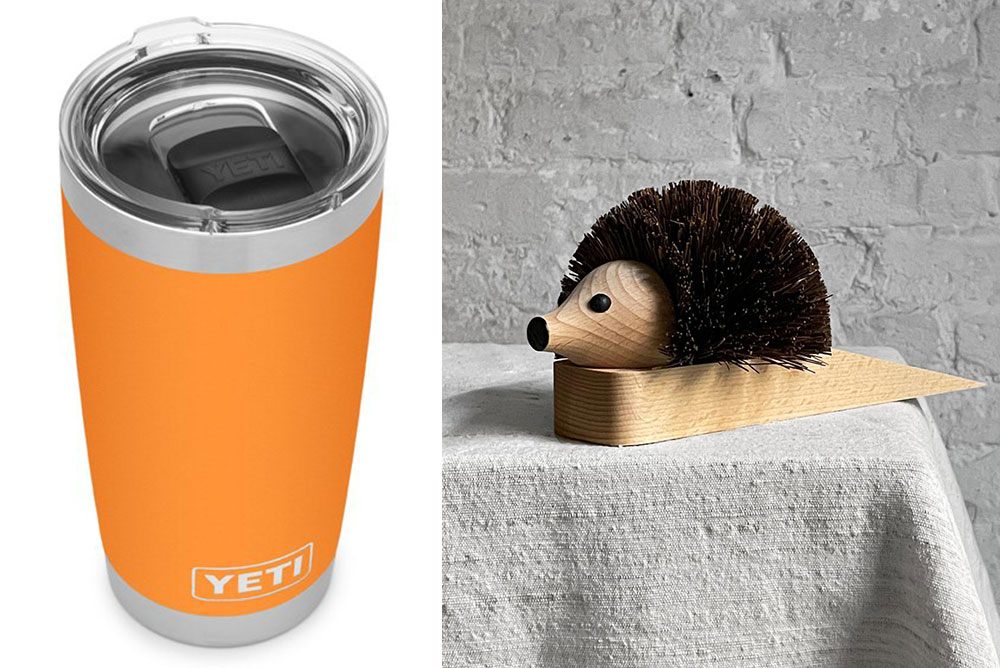
LEFT: Dads on the go, whether from golf course to tennis court or from school pickup to soccer practice, will appreciate the Yeti Rambler 30-ounce Tumbler with Magslider Lid ($34.99) to get them through the day, from hot cup of joe in the morning to an icy drink in the afternoon. Stainless steel with double-wall vacuum insulation prevents heat or cold from escaping; the magnet lid helps keep liquids from spilling out. The tumbler is available in lots of bright hues, and oh, by the way, you can put it in the dishwasher.
RIGHT: The dog waits at the door for Dad to walk him. This cute little fella, on the other hand, sits at the door waiting to serve Dad. The oiled-beechwood hedgehog, made by hand in Germany by the family-run Redecker company, can prop the screen door open and let Dad scrape the dirt from mucky shoes with its bassine bristles (from sago-palm leaves). Or it can just sit there looking quite a bit like the dragon Ollie from early TV’s “Kukla, Fran and Ollie.” The 10-inch-long doorstop/bootscraper is $45 at John Derian.
By Janet Kelly
WEARING A mask for 14 months and change made me mostly forget about makeup with the exception of a swipe of mascara every so often. But now that going mask-less is more and more the norm, I suspect it’s time for a refresh in my routine. Not talking full regalia here—just some basic products: a light tinted moisturizer/foundation, concealer, mascara, blush and a lip gloss or balm. As for what to spend the big (ger) bucks on, makeup artists concur that you should spend the most on the largest surface area—the theory is that if your skin looks polished, then you can get away with less expensive eye and lip products.
Even the spendiest mascaras should be tossed after a few months, so that’s the appeal of drugstore mascaras. Likewise, lip balms and lip glosses don’t last long so no need to splurge. But buying a multi-use makeup stick is worth the extra cash. If you can use a blush on your lips and eyes, then a higher price is more acceptable.
I like to dabble in makeup, mixing lip balms from Burt’s Bees, concealers and foundations from The Ordinary (see more below) and drugstore blushes with Westman Atelier’s high-end highlighters and luscious lip glosses from Dior. Go ahead, have some fun with your makeup.
Here, our picks for recharging your cosmetic bags post-pandemic.
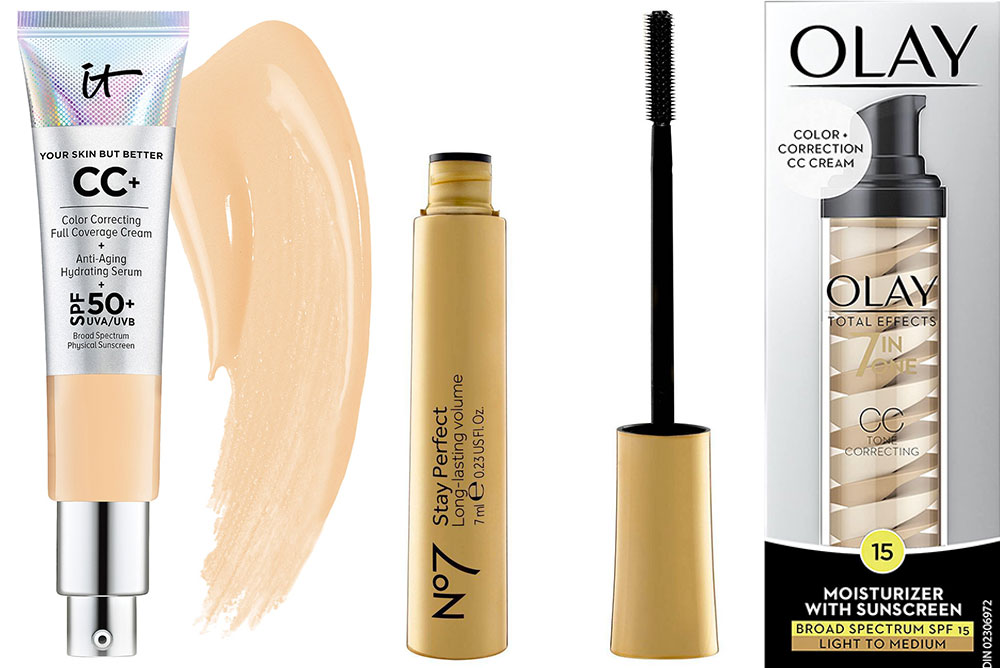
LEFT: IT Cosmetics’ Color Correcting Full Coverage CC + Cream ($39.50) already has SPF 50 UVA/UVB protection, so that’s a save on sunscreen. Furthermore, infused with hydrating hyaluronic acid, the cream can help camouflage dark circles, redness and large pores.
CENTER: Last year I purchased a Boots No 7 mascara, and it does the job as well as my high-priced products. The company’s No 7 Stay Perfect Waterproof Long Wear Mascara ($8.99, Target) is a good bet for summer when you don’t want your eye makeup melting down your face in the heat.
RIGHT: If you prefer lighter coverage, another CC cream, this one from Olay— Total Effects Tone Correcting Cream ($23.99, Amazon) checks that box. It has an SPF 15, so you’ll likely need to apply another sunscreen underneath if you’re out and about in the sun. That said, Olay products are popular and sell out quickly. There’s only one left on Amazon, and it’s sold out on the Olay site.
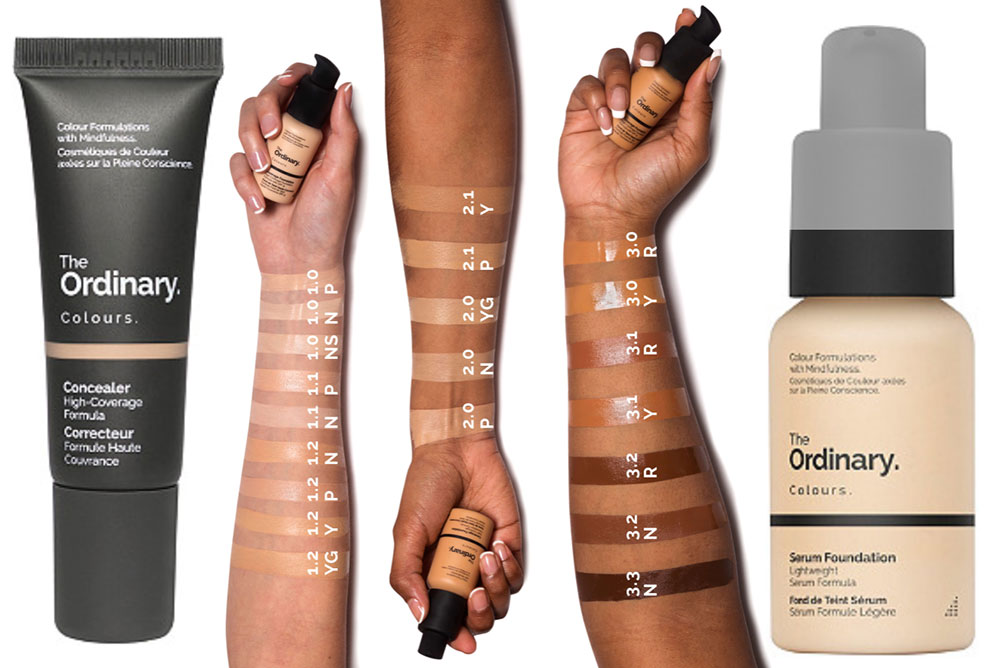
LEFT: A beauty industry rebel, The Ordinary uses pricey ingredients – from rosehip to retinol – sans all the fancy frills and produces effective formulas without the mega price tags. Take The Ordinary Concealer ($5.80, Ulta), for example, which offers coverage in a range of 21 shades.
RIGHT: The Ordinary’s lightweight Serum Foundation ($6.70, Ulta) will work for those who want moderate coverage. It is also available in 21 shades with a classification system that notes the depth, tone and undertone of the selected color. For example, 1.1P is for the very fair skinned with pink undertones. But you can see how it looks on you, using the Ulta Try It On app.
 LEFT: Sleek, sexy packaging must account for some of the hefty price tag on the Westman Atelier Baby Cheeks Blush Stick ($48, Violet Grey). But using other products in the line (such as the Lit-Up Highlighter) and seeing the effects has made me a believer in makeup artist Gucci Westman’s products. The blush stick comes in six colors, two of which are sold out. Rationalize the cost—you can also use on the lips.
LEFT: Sleek, sexy packaging must account for some of the hefty price tag on the Westman Atelier Baby Cheeks Blush Stick ($48, Violet Grey). But using other products in the line (such as the Lit-Up Highlighter) and seeing the effects has made me a believer in makeup artist Gucci Westman’s products. The blush stick comes in six colors, two of which are sold out. Rationalize the cost—you can also use on the lips.
CENTER: I can’t resist the pull of an inexpensive drugstore buy like this Wet n Wild MegaGlo Makeup Stick Blush ($4.49). Thanks to Ulta’s try-on app, you can see it on you before you buy. And it’s the same price as the drugstore’s.
RIGHT: Speaking of drugstores, you can frequently find Burt’s Bees products on the shelves for skincare. All Aglow ($12.99) makes the cut for anyone who wants just a healthy flush of color on lips and cheeks.

LEFT: Honest Beauty’s sheer, buildable shades, such as summer melon and lychee fruit, contain avocado oil, açaí and pomegranate to keep lips feeling smooth and smoochable. The Tinted Lip Balm is $9 at Ulta, and you can try it on virtually.
CENTER, ABOVE: For that lit-from-within look, try Milk Makeup’s Glow Oil Lip+Cheek ($15 for mini size .18 ounces, Sephora). It is shimmery, so avoid if that’s not something that appeals. It comes in coral, bright pink, mauve and plum.
CENTER, BELOW: Swipe on Ilia’s creamy Multi-Stick Dreamer ($34) for a warm wash of color. It comes in 8 shades, including hot tangerine and warm watermelon.
RIGHT: Dior Addict Lip Maximizer Pumping Gloss ($35, Sephora) is way pricier than a lip gloss should be, but I’m still inclined to buy it again. It feels deliciously rich on your lips and comes in colors, such as cherry pink and mahogany, with a high-shine finish. If you think it will plump your lips, though, you’ll be disappointed. For that, you’ll have to visit your dermatologist.
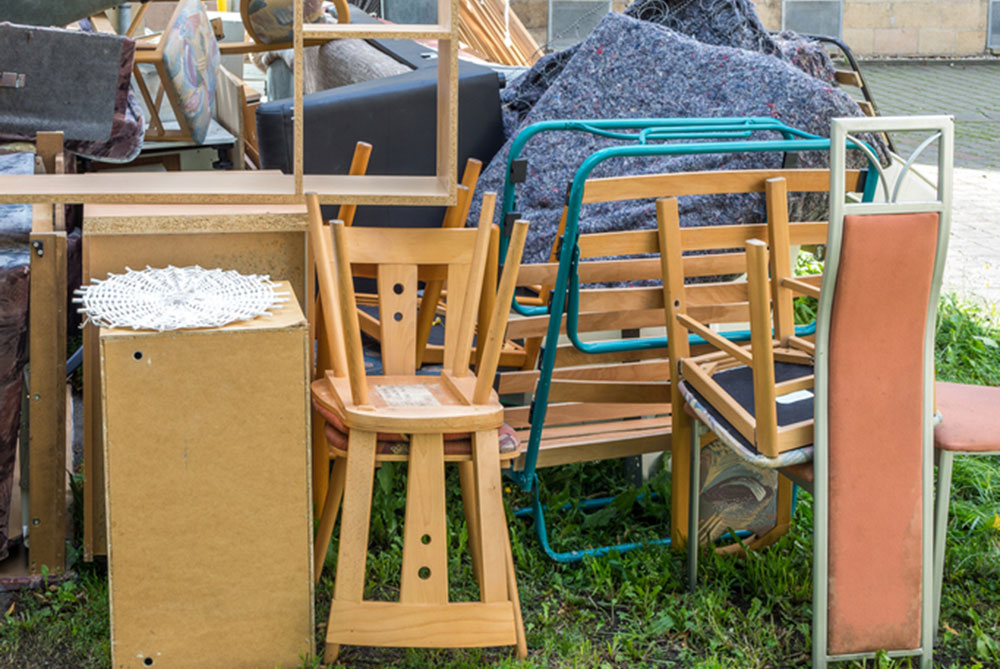
iStock
I have three fine leather belts in my closet, and I never wear a belt. I’m not sure how they got there. And the shoes! Imelda Marcos I’m not, but since I pretty much wear either my plastic Crocs or the same pair of boots every day, and sneakers at the gym, who are those other 50 pairs for? And what about the ceramic birdbath and the 40-odd terracotta pots? Why do we have four rakes? How did we get six snow shovels?
One solution would be to burn my house down and start fresh. That sounds glorious, especially the part where all of my husband’s boxes and boxes from grade school, full of love letters and blue ribbons and penmanship exercises, would go up in flames. But arson is against the law, something about insurance fraud. Too bad we don’t live in a flood zone.
So we had a yard sale last fall and maybe 20 people came. I sold next to nothing. Mainers are thrifty. How thrifty? I had something marked two bucks and a guy offered me one dollar and I said no and he walked away. That’s how thrifty. And besides, they all have their own stuff.
Good news! Our landscape guy just came by to drop off some plants for the yard (more stuff), and I was able to give him the bird bath. He said his wife has been wanting one. It cost $80 originally, but I said he should just take it as a gift. We quibbled, but I persisted. I feel lighter already.

iStock
By MyLittleBird
LAST OCTOBER, we asked what you were wearing during the pandemic? Were you sticking with sweats or were you upping your game, buying nicer pants, new eye makeup and treating yourself to a bauble or two?
At that time, we didn’t ask how much you bought, but when we read a recent Wall Street Journal article reporting that Americans bought 54 items of apparel in 2019, up from an annual 48 items, MyLittleBird’s jaw dropped. So, we had to inquire: What have you bought lately—in 2019 or since? Did it come close to the number in the WSJ??
Here’s what you told us:
Maureen Young: The answer to your question is YES! I can’t seem to help myself when I walk to Shadyside these days! Thinking back almost a year and a half since I left my Barcelona rental because of Covid— lots of shoes and summer dresses and shorts and tops to replace what I left behind. But also several dresses, blouses, skirts and purses— yikes! I’m not usually into buying clothes because I grew up wearing uniforms! But nothing else to spend my money on!!! Six jackets, five dresses, one raincoat, two skirts, five dressy blouses, six T-shirts, and jeans, shorts, dressy pants, several purses, 12 pairs of shoes, etc.,etc., etc.!!!
Jacqui Michel: I shopped like a fiend and after gaining COVID weight, I had to go into bigger sizes so I got to that number at least.

Kathy Legg: White v-neck Gap T-shirts. That’s about it for clothing. But I also bought a new roof, patio furniture and I’m about to buy a new knee. Do those things count?
Mary Favello: I bought about 25 items of clothing, including jeans, summer tops, a purse, coats, shoes and lingerie. I also bought moisturizers. In addition to clothes, I contributed to the economy big time. I put in a new kitchen and upgraded a bathroom and a closet. And then there was Christmas. Put a dent there for my family.
I think what it was is we had so much extra time because we were confined, we looked at ourselves differently. I gave away bags of clothes that I probably shouldn’t have bought in the first place.
Stephanie Cavanaugh: Bought nothing until last month when I unexpectedly landed in Florida for a family emergency and needed shorts. Thank you, Amazon. And a couple of tank tops. Thanks again, Amazon. Total expenditure south of 40 bucks. Filled in with three swell shirts at the Juno Beach hospice thrift shop, not sure who to thank for those. Total expenditure there, thirty bucks. That makes eight items.
I do need a new bathing suit, but that’s not a bought, it’s a gonna buy.
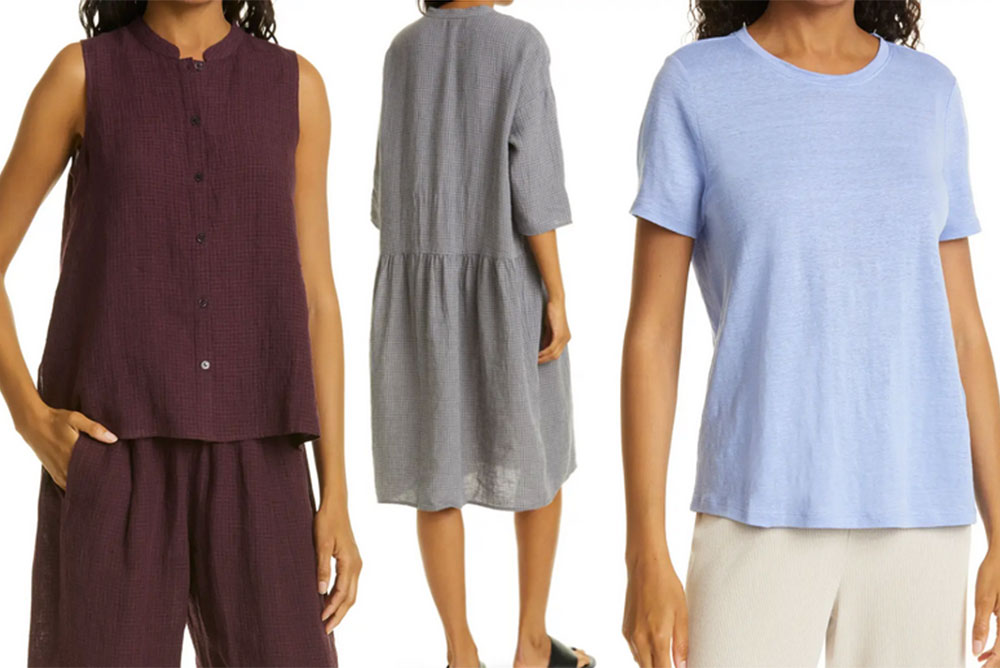
Jura Koncius: That’s a crazy number. Does it include shoes?
I recently stocked up on basics at Eileen Fisher. I got two black high-neck tanks, one white tank, a white crocheted sweater, a white flat knit cotton cardigan sweater, a gray flat knit cotton sweater, white washable crepe slim ankle pants and black washable crepe slim ankle pants.
Those eight items should be all I need for now. I just ordered a black and a white viscose tee shirt from Eileen Fisher as many of the system basics are being discontinued—and there will only be a core group left—I love these and am annoyed they won’t be part of the regular line. Also I ordered like five black and gray cotton turtlenecks from Lands End in December for wintering at home—putting them away just now decided I didn’t really need that many.
I think the WSJ number must be fast fashion bought by millennials. I am constantly weeding my wardrobe to be less and less.
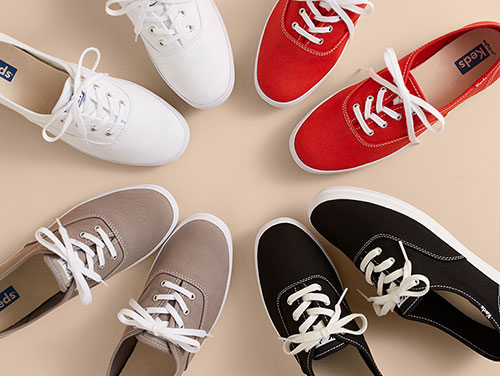
Linda Kastan: I did buy a few apparel items online in 2020 (who remembers 2019?), including about seven pairs of sneakers (maybe more) and six pairs of socks, but all together, they probably did not amount to 54.
Judith Robinson: What I have bought most recently is a pair of New Balance sneakers, black, which I am still in the process of “breaking in.” I have a bad toe joint on my right foot (too many years in pointy-toed high heels) and now have trouble finding shoes that don’t hurt! Sorry to not have a more glam purchase to report!
Carol Lichty: Not sure what I bought in 2019… but don’t think it was much different from 2018. But in 2020 I bought (at least) three pair of spring shoes with closed toes because I couldn’t get a pedicure yet plus a couple pair of casual capris. And I always add a few new white tops for summer. Pretty sure not much else last year. I would look and decided to wait since there was nowhere to go except the grocery store. This year will be another story!! Already bought two spring jackets from your recommendations and actually just ordered a linen maxi dress for a good friend’s 80th birthday (yay, a party!) in June from Talbots. (They had a $50- off-dresses weekend.) The other thing on my list to buy soon is new underwear, seems all of a sudden bras and panties looking worn. I remember reading an article years ago that when intimate wear sales went up it was a sign of a good economy?!
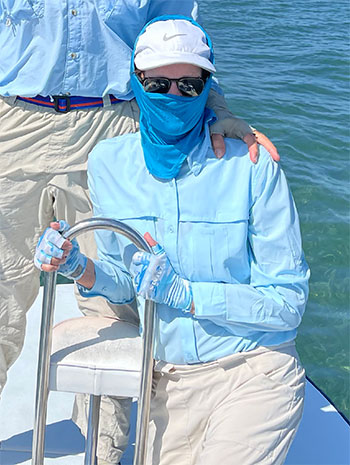
Darrylyn Kaun: I bought special pants, booties, socks and gloves for a trip to the Bahamas in early May to go bone fishing. I know people who bought lots and lots of clothes—think they were just bored.
Caren Sniderman: I bought almost nothing during the pandemic. One pair of comfy sweats. This year, I have bought a couple of golf and tennis tops to coordinate with skirts and shorts I already have to get a fresh look. And one fancy top for a couple of weddings this year. Nowhere near the WSJ numbers— even in a good year.
Abigail Cook: Retail, nothing, thrift maybe 10 items. Shirts mostly or sweaters but maybe some lightweight jackets.

iStock
This weekend is a time to remember all the ones we’ve lost and to be grateful for what we have.
All photos courtesy of The Museum at FIT.
THE NEW Netflix series “Halston” takes us back to the ’70s and some of the fascinating people who dominated the era, including Liza Minnelli, Elsa Peretti, Eleanor Lambert and of course, the designer himself.
Seeing the series left us wanting to dig deeper into the story. We asked Patricia Mears, deputy director of The Museum at FIT and organizer of the 2015 exhibit, “Yves Saint Laurent + Halston: Fashioning the 70s,” about how Halston exemplified this time in fashion history.
MLB: What do you think accounts for the renewal of interest in Halston— the TV series and the documentary in 2019? He was a superstar in the late ‘70s and early ‘80s, but I think since then, forgotten.
PM: The show focuses on the sensational parts of his career, but that’s only part of the story—the one that makes good TV with a lot of sexy, beautiful people.
MLB: How do you see him?
PM: His is the classic American story. He’s a milliner who works within a rigid structure and then makes a quantum leap into fluid clothing. He makes a lot of money and then loses it all—it’s a rags-to-riches tale and then back again. He dies of AIDS far away from New York and the fashion industry.
MLB: Talk a little about the ‘70s and fashion.
PM: It was a time of big changes—in the more relaxed look of clothes and how they were designed, distributed and consumed. In between the hippie 1960s and the heady 1980s, the decade led to the beginning of designer-led conglomerates and the rise of celebrity culture.
MLB: What was he most famous for?
PM: He was ahead of his time, a pioneer in creating the concept of a huge conglomerate. He became famous for being famous. Halston created a spare but luxurious set of pieces that became the foundation of his daytime designs for women. They were similar to Halston’s daily uniform of a cashmere turtleneck, matching cardigan or loosely cut jacket and a pair of trim trousers. His most famous garment, the shirtwaist dress, was an adaptation of a man’s shirt. Made of Ultrasuede, a machine-washable fabric, the dress was subtle and sexy, with buttons that began at the breastbone rather than the neckline. It became a fashion staple.
MLB: Which designers had the most influence on the work of Halston?
PM: The sinuous, bias-cut gowns of Madeleine Vionnet from the 1930s inspired him as did influences from the 1940s, including the cashmere sweater sets of Mainbocher and the ties and closures used by Claire McCardell.
MLB: Why is he considered such a formidable designer?
PM: He had an amazing eye and brilliant sense of proportion. He was extremely focused. In fact, he was a workaholic throughout his career. He didn’t live the heady, drug-infused lifestyle until he was middle-aged in the late 70s and 80s, when the demands of the business were extremely stressful. He didn’t have a huge range of design; it was narrow but profound. He liked to take one idea and keep working on it. His designs were simple, but a lot of thought went into details, such as how tight an armhole should be.
MLB: You organized a show comparing Yves Saint Laurent and Halston. How do they compare?
PM: Halston’s designs stand the test of time. They’re visually pared down—he didn’t use buttons or zippers; Saint Laurent used interior corsets. There’s a seamlessness to Halston’s clothes; they caress the body and have movement.
MLB: Is his influence still being felt today?
PM: When Tom Ford went to Gucci in the 90s, his first collections were inspired by Halston—pure and distilled yet sexy at the same time. Ralph Rucci also pays homage, along with many others who have adopted his aesthetic without even realizing it.
MLB: Does the TV series on Halston have some benefit?
PM: Yes, people will learn about a great American designer.
—My Little Bird Staff
In conjunction with the release of “Halston” on Netflix, Halston’s chief creative officer Robert Rodriguez is designing a custom 10-piece collection based on the key looks from the show. The capsule will be available at Neiman Marcus, Saks and through the website. Pre-orders will start the week of June 7.
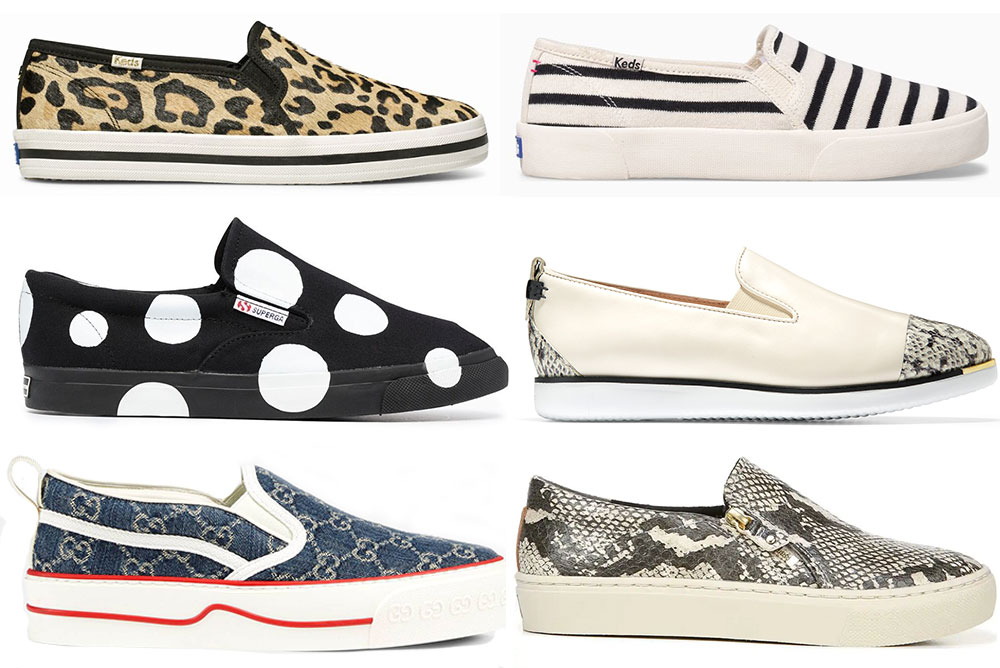
By Janet Kelly
Gone but not forgotten, high heels have been slipping into our rearview mirrors for a while now, especially so during the pandemic. But even pre-pandemic many of us were switching to sneakers for comfort and stability. Circa 2018, there were those clunky, “ugly,” very spendy sneakers from Prada and Balenciaga, as well as comeback classics from Adidas and Tretorn. Credit the athleisure trend. Then, fast forward to 2020 and Covid-19, with no place to go but from kitchen to living room to bedroom and back, and we settled into our cozy corners.
As we start to emerge this spring and summer, we’re asking ourselves what’s next. We’re betting on cautious optimism. City sidewalks are as good a place as any to gauge fashion temperatures and from what we’re noticing on the streets, women of all ages are still wearing sneakers, many of them preferring slip-on styles. That’s not new, but what is is those slip-ons are sporting floral, animal print and plaid patterns—an easy step up from sneakers but with the same comfort level. What appeals is they’re flat and have a thick, resilient sole to absorb the shock from concrete sidewalks. We’re looking at you, city dwellers.
Old-school brand Keds is getting on the bandwagon of easy-to-wear slip-ons, collaborating with high-profile brands like Kate Spade; Vans offers almost as many slip-on styles as traditional lace-ups on its website.
One thing to note: as we all feel the freedom of a return to a more normal way of life, it’s important not to go overboard when choosing shoe patterns and colors. For example, it may be best to avoid, say, a neon orange. If you do pick an exuberant pattern, keep the rest of your ensemble clean and simple.
Here, fourteen of our favorites.
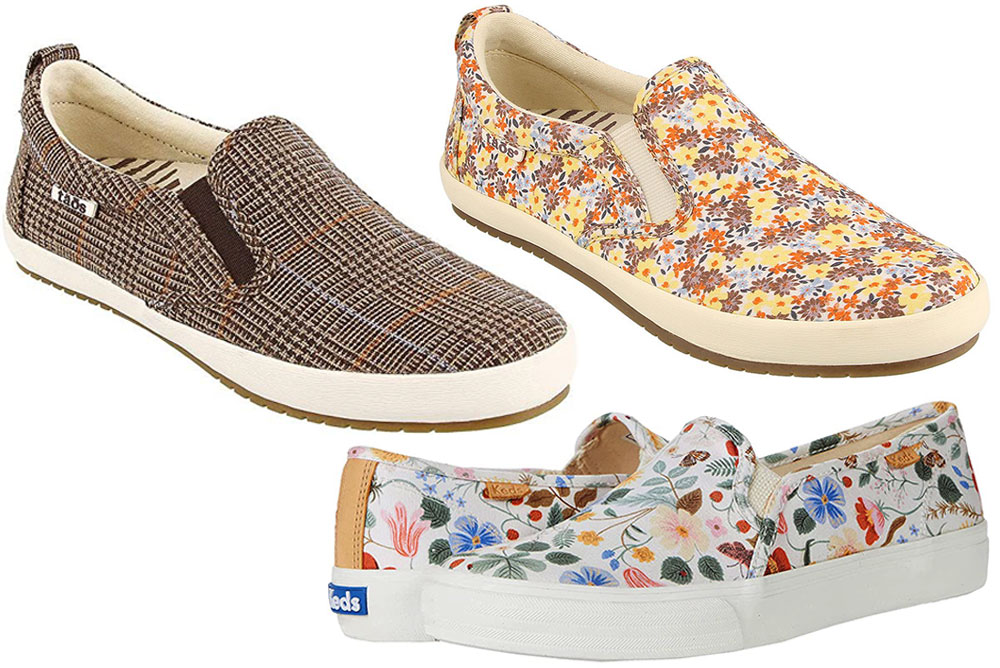
LEFT: I’ve worn my Taos navy blue canvas slip-ons so much the fabric at the heel is tearing. (I also have a pair of lace-ups in saddle brown.) What I like is they just cradle your feet. Clearly, I’m a fan; but when I give my old ones up, I’m going for something less plain like this plaid but still subtle Dandy Slip On ($64.19, Amazon).
RIGHT: The Dandy Slip On ($89.95, Amazon) also comes in leather with a floral print for a step-into-summer-with-whimsy look.
BELOW: Keds is upping its sneaker game by teaming with different brands, including Rifle Paper, a Winter Park, Florida, stationery and lifestyle company. Here, the Double Decker ($69.95, Zappos) with the traditional Keds sneaker silhouette—in leather— is printed with the paper company’s signature, a fun floral print.

LEFT: Rothys takes plastic bottles from landfills and transforms them into the brand’s own thread, which is then knit into durable, washable and sustainable styles like this Blue Spot ($125) sneaker with a painterly leopard print.
RIGHT: Vogue is predicting that gingham will be one of this summer’s “breakout” prints, thanks to the likes of designers Rodarte, Altuzarra and Larroudé. Embrace your sweet side in a pair of Leo and Teddy Gingham Slip on Canvas Shoes ($65, Etsy).
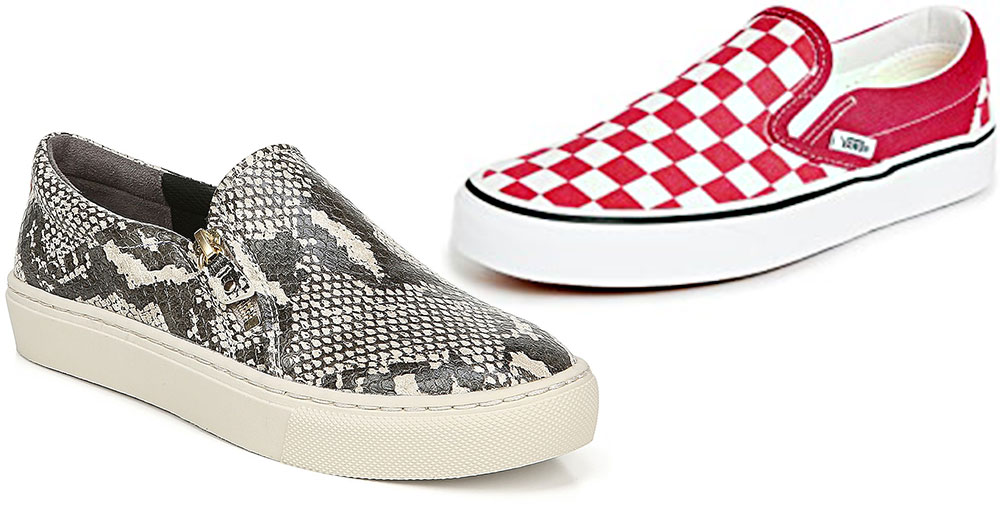
LEFT: If you have a high instep, you’ll be grateful for the side zipper as you’re slipping on Dr. Scholl’s No Chill Platform ($49.99, DSW) in faux leather. A cushy footbed energizes tired feet.
RIGHT: How sporty and cute is this cherry-pink checkered print UA Classic Slip On from Vans ($30, Shopbop)?

TOP LEFT: This leopard print ($109.95) on calf’s hair, courtesy of a collaboration with Kate Spade NY, makes a, er, wildly wearable flat.
TOP RIGHT: Another Keds collaboration—with maternity brand Hatch—the Double Decker Bateau Stripe ($74.95) will work for any woman at any stage of her life. Note the ventilation holes for added breathability. It looks vintage French Riviera to us.
BOTTOM LEFT: Iconic Milan concept store Corso Como 10 that mixes fashion, design, art and culture and Turin-based sneaker brand Superga got together to produce these polka dot print statement Slip-On Sneakers ($146, Farfetch).
BOTTOM RIGHT: Cole Haan worked with the University of Massachusetts Amherst’s Biomechanics Laboratory for its Grand Ambition collection, designed for optimum fit, feel and flexibility. We thought this one with a leather upper and a metallic toe detail looked rather spiffy ($170).
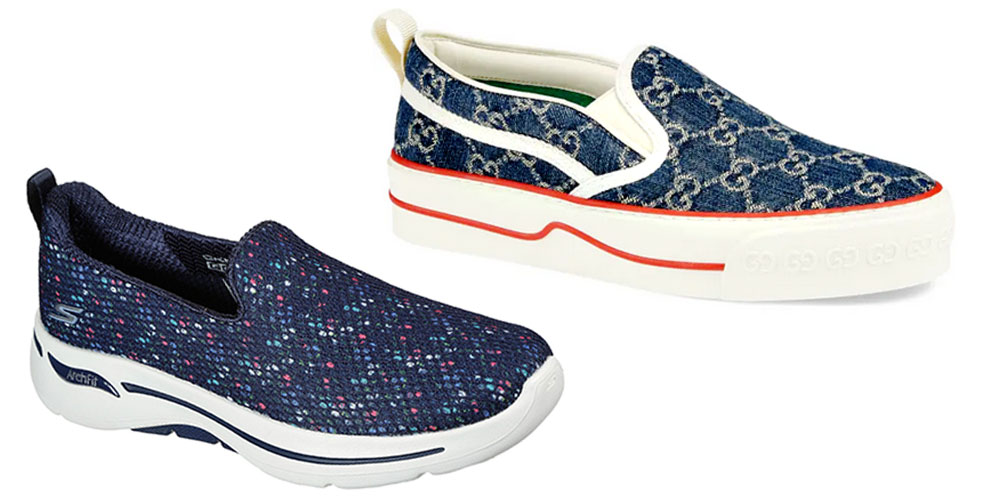
LEFT: Ever since my Pilates class instructor, a former dancer, heaped praises on her Skechers, I’ve been game to try a pair. If a backyard barbecue or cocktails on the patio are in the offing, say for Memorial Day or the Fourth of July, what better way to celebrate a new normal than with the colorful and comfortable GoWalk Arch Fit Fiesta Fun Shoe ($80) with removable insole and lightweight cushioned midsole.
RIGHT: Pulled from the archives, the Gucci Tennis 1977 Slip On Sneaker ($630) is reimagined by creative director Alessandro Michele. Original details like heritage logo stitching meet jacquard denim. The red stripe on the sole seals the deal for a red, white and blue holiday weekend.
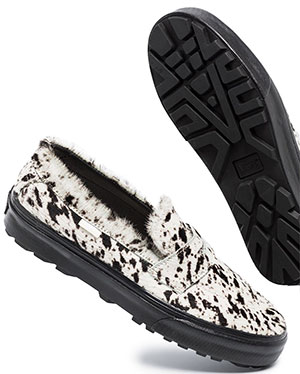
ABOVE: A brand-new style from Vans, these pony hair 53 DX Slip On Sneakers ($157, Farfetch) with a fluffy faux fur trim look a lot like loafers, yes? But a lot more flexible. And instead of the usual leather sole on loafers, they’ve got a chunky rubber one with a textured tread. For anyone not sure they want to transition from sneakers to loafers or flats just yet, here’s something in between.
MyLittleBird often includes links to products we write about. Our editorial choices are made independently; nonetheless, a purchase made through such a link can sometimes result in MyLittleBird receiving a commission on the sale, whether through a retailer, an online store or Amazon.com.
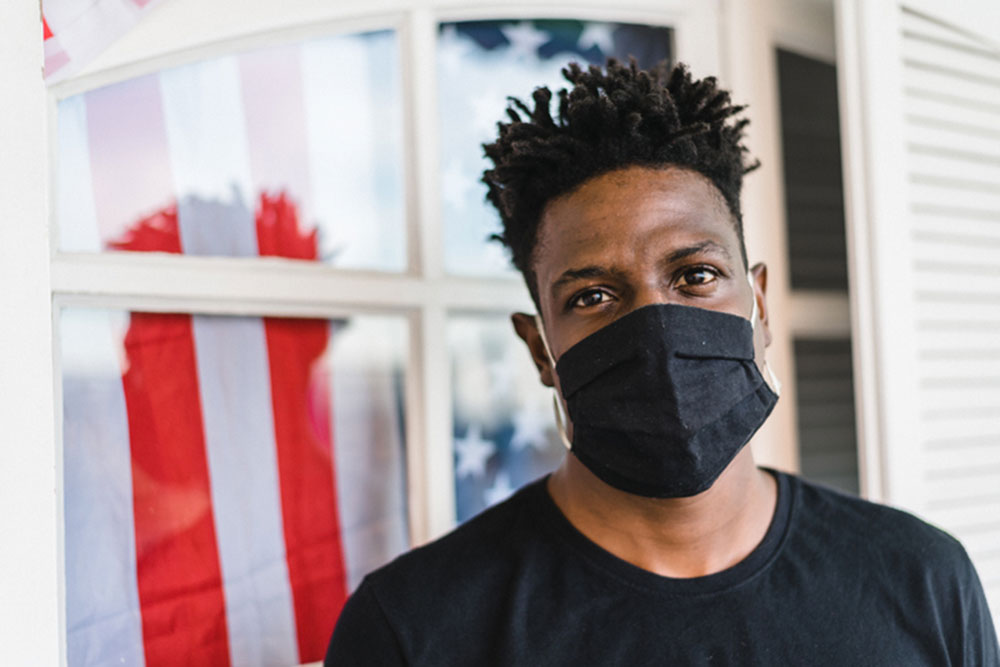
iStock
THE RECENT controversy over a JAMA (prestigious Journal of the American Medical Association) podcast—along with “racial inequities in medicine…Black Americans contracting the coronavirus and dying from it at higher rates thanks to decades of medical racism,” according to the Washington Post —prompts an update of Mary Carpenter’s post on racism in U.S. medicine from last year.
JAMA and other “elite medical journals have routinely excluded, minimized and mishandled issue of race,” according to complaints following the podcast, which serves “to perpetuate and entrench health inequities that have long harmed and shortened the lives of people of color.”
Medical researchers told Statnews about being “explicitly told” to remove the word racism from their work. In an egregious example of racism, last August’s Journal of the American Heart Association included an article arguing that educational programs intended to increase diversity would produce poorer clinicians.
In the podcast, one JAMA editor questioned using the term racism at all because it “involves feelings among people,” and JAMA’s promotional tweet for the podcast made the unacceptable statement that no physician is racist.
Among racist practices receiving new attention with Covid-19 is placing blame on genetic rather than social factors for higher rates of Covid-19 deaths and hospitalizations —which fails to pinpoint structural racism as a cause. A more specific example, the dearth of images using dark skin in dermatology medical literature can impede the assessment of rashes on the toes and elsewhere linked to Covid-19—leading to incorrect and life-threatening diagnoses.
The standard kidney assessment adjusts for the dated racist assumption that black people have higher muscle mass and thus better kidney function. The test results—deeming the kidneys of many black patients in better shape than they are—can delay treatment or eligibility for transplant, often placing patients so low on wait lists that they die before having the chance to receive a new kidney.
More difficult to address are the racist medical practices that stem from “implicit bias,” which includes a range of beliefs, especially affecting evaluation of pain. At least one life-threatening consequence of treating black patients differently is the three and a half times greater likelihood of healthy black children dying during surgery compared with white children.
While high rates of adult black patients’ deaths during surgery are often traced to overlapping health conditions or risks, black children with no underlying conditions still had a higher rate of death and complications after both elective and emergency procedures than their white peers.
Among outdated racist practices and beliefs from the past that persist today, commercial spirometers used to diagnose and monitor respiratory illness have a “race correction” built into the software to control for blacks’ “lack of lung capacity,” as described by Thomas Jefferson.
The spirometer’s designer, Louisiana physician Samuel Cartwright, estimated blacks’ lung deficiency at 20% and suggested treatment using forced labor to “vitalize” the blood. (Cartwright also described a disease of the mind called drapetomania that caused enslaved people to run away from their enslavers.)
While the proportion of images using dark skin in dermatology textbooks ranges from 4 to 18%, the one exception is sexually transmitted diseases—with images using black skin appearing twice as often for infections that are sexually transmitted, compared to 28% of images using black skin for infectious diseases in general.
The dermatology bias creates a painful reminder of the Tuskegee researchers who withheld diagnosis and failed for decades to treat black men with syphilis. Black skin was also the object of racist experimentation in the 1900s by Georgia physician Thomas Hamilton, who created blisters and then cut into the skin of one slave while attempting to prove that black skin was thicker than white skin.
While areas of medical bias, such as textbook images, may take longer to correct, objective measurements involving the spirometer and kidney tests could be easy to change. The kidney function test that measures “estimated glomerular filtration rate” (eGFR)—the ability of the kidneys to filter waste from the blood—includes a variable of race (along with age, gender and levels of the waste product creatinine) that allows for only two groups, black and not black, with points added to raise the scores for those in the black group.
Individual medical institutes have started adjusting for muscle mass instead of race, but some physicians argue that any role of muscle mass is medically unfounded and call for eliminating this variable entirely. The National Kidney Foundation has affirmed that “race modifiers should not be” part of kidney function assessments, and that current equations should be replaced by those that are “accurate, inclusive, and standardized.”
Looking at implicit bias in medical practice, studies of medical students repeatedly find widespread beliefs that “black people’s nerve endings are less sensitive than white people’s… their skin is thicker.. their blood coagulates more quickly,” writes University of Washington health researcher Janice Sabin.
Implicit bias has the most impact in medically ambiguous situations. For pain that has no clear cause, such as traumatic injury, providers rely more heavily on their personal judgment. In addition, the media often exposes medical providers to stereotypes and images, that, for example, associate black people with substance abuse and drug-seeking behavior.
A meta-analysis of research over 20 years that included many sources of pain found that black patients were 22% less likely than white patients to receive any pain medication—with the greatest disparities for conditions like backache, migraine and abdominal pain.
Many people find it easier to recognize pain in faces like their own—making it easier for white medical providers to assess pain in white faces. “We are in the midst of an Implicit Revolution,” writes Sabin, “bringing new insights into how our minds work…we operate at the unconscious level much more than we ever imagined.”
Exercises like taking the “Implicit Association Test” can help medical providers recognize and acknowledge their biases. And learning about disparities in pain management can help clinicians improve their practices. But some experts put their greatest hope in finding more objective measures—for pain, a blood test using biomarkers could measure intensity.
In White Fragility, Robin DiAngelo explores the evolution of racism in American medicine. Early in U.S. history, “tension between the noble ideology of equality and the cruel reality of…enslavement…had to be reconciled. Jefferson and others turned to science…Race science…legitimized racism and privileged the status of those defined as white.”
She explains, “The idea of race as a biological construct makes it easy to believe that many of the divisions we see in society are natural. But race, like gender, is socially constructed. Under the skin, there is no biological race.”
—Mary Carpenter
Mary Carpenter regularly reports on topical issues in health and medicine.

By Janet Kelly
SEVERAL years ago My Little Bird’s Nancy McKeon and I were in NYC on what had to have been the coldest day that winter. We took a break from work on a fashion shoot to walk several frigid blocks to a sample sale of designer Dennis Basso, known for his glamorous outerwear and luxe accessories. Nancy scored a gorgeous wallet and insisted, nay, bullied me into purchasing a cream-colored, buttah-soft leather jacket. So happy she did. I’ve been it wearing it every spring since. And on many fall days as well.
Of course, no jacket covers you for every occasion. If you’re thinking of spending on a spanking new one, consider your lifestyle and which will give you the most wear and bang for your buck.
Thanks to a designer named Nanushka, in addition to leather jackets, there are now an abundance of faux-leather jackets on the market from mass market chains Mango and H&M to niche labels like Alice + Olivia. For spring and summer, lightweight bomber styles look especially appealing in pale colors. Anoraks in treated or weatherproof fabric from Rains, Banana Republic and Anthropologie withstand the wind and keep you dry. And they’re breathable when the weather turns warm and soggy.
Whether you’ve got a laundry list of tasks to finish—clean closets, clear the garden—and/or lots of places to go, chore jackets from Everlane and J. Crew get you through the day looking good. For more posh and polish, there are Parisian-chic choices from Iro. Fashion-forward? A cropped trench coat from Free People to a limited-edition satin bomber from Rodarte.
But see for yourself. Here are our picks below:

LEFT: Clean-lined Scandinavian style and function meet in this coated, waterproof Rains jacket ($110, Shopbop). A drawstring hood keeps those raindrops from falling on your hair.
RIGHT: Montreal brand Lamarque specializes in high-quality leather jackets. The studded embellishments on this one ($675, Anthropologie) give it plenty of personality. Pair with a floaty spring dress.
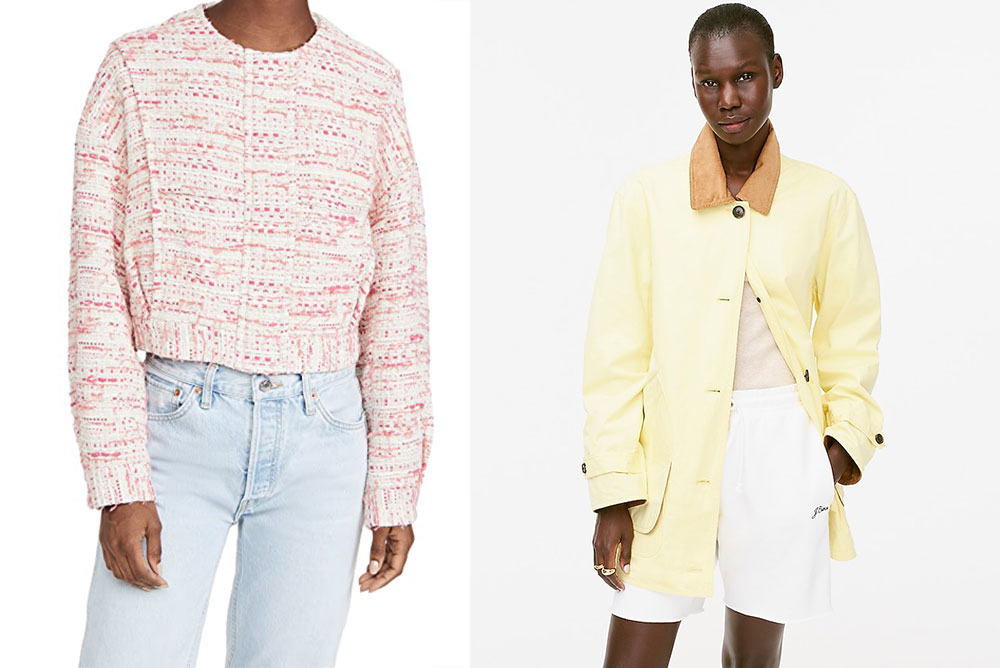
LEFT: Iro’s Jengo Jacket ($645, Shopbop) updates the look of a classic Chanel tweed with a cropped bomber style. The pink and white threading adds a pretty pop of color to light blue or white jeans.
RIGHT: A Relaxed Barn Jacket in lightweight cotton canvas ($158, J. Crew) sports military details—oversized pockets and tabs—but the fit is straighter and the length longer. Think things like walking the dog and easy hikes. It’s available in four other yummy pastels—lilac, flamingo, cypress and pale chambray. Take 25 percent off the full price with code FLASH.
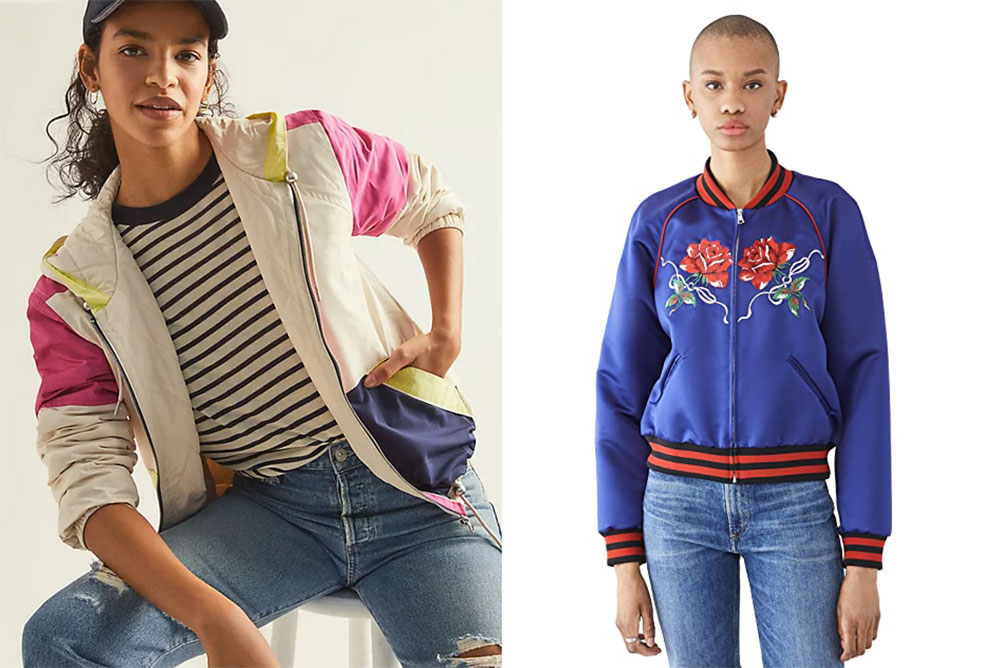
LEFT: Bad mood? Rain or shine, brighten your outlook in this Venus Neon Windbreaker Jacket from Anthropologie. It’s $168.
RIGHT: In the hands of the Los Angeles-based Mulleavy sisters, Kate and Laura, clothing blurs the line between art and fashion. The Satin Rose Embroidered Bomber Jacket ($1,380) from their Rodarte label is a bit of both.
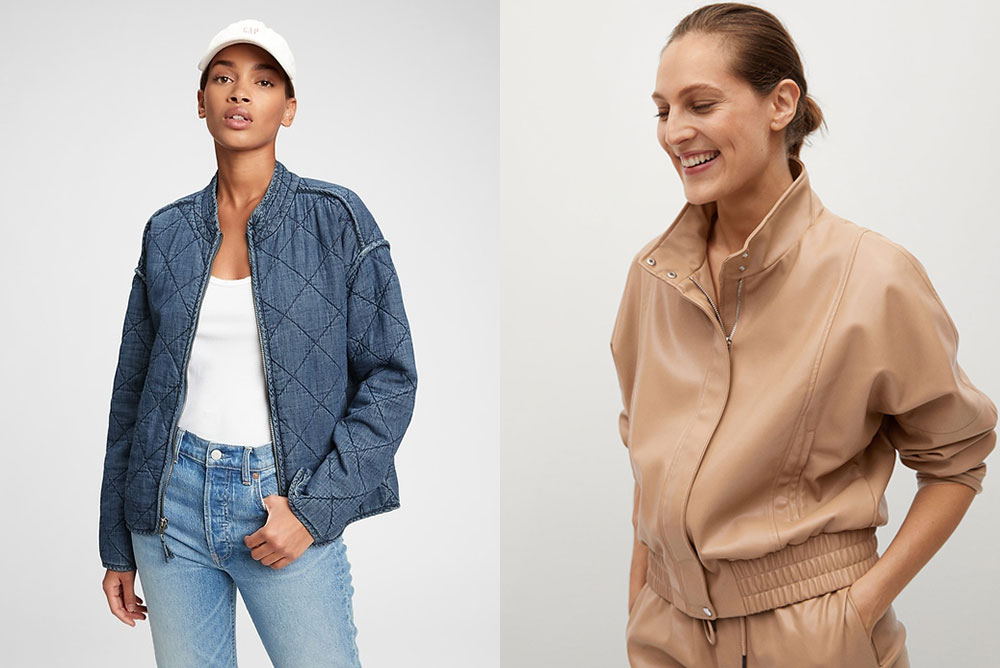
LEFT: I’ve had my eye on Gap’s Denim Jacket ($128) for a while. It looks so darn comfortable, and the quilting is so au courant. Plus, Gap is always having a sale.
RIGHT: Nanushka, who ignited the faux leather trend in 2020, sells her vegan leather bomber for $775. For the same cool, casual look without the hefty price tag, opt for this one from Mango for $99.

LEFT: I think of Free People as a brand for twenty-somethings, but every now and then I notice something oh-so chic for all ages like this Brenda Aviator Trench Coat ($148).
RIGHT: It’s the color on this Banana Republic Water-Resistant Jacket (reduced from $149 to $74 Banana Republic) that grabbed our attention. It’s made from a light cotton twill that’s treated to repel the rain.
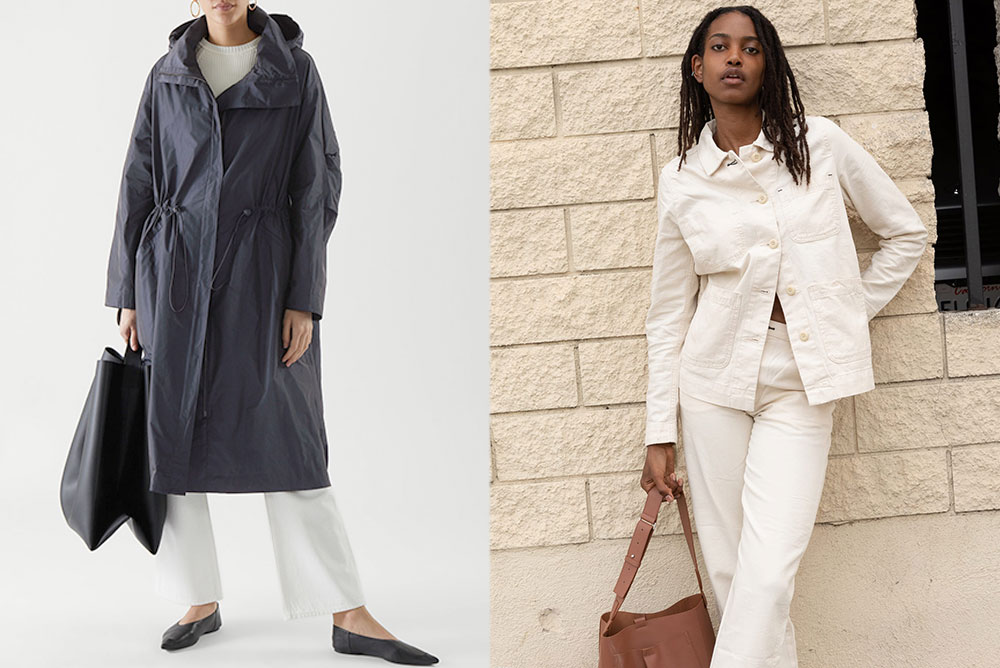
LEFT: More coat than jacket, Cos Stores’ parka ($190) has got you covered when spring storms and drenching downpours come along. And when it’s wet and sodden, you’ll be glad it’s so lightweight. A chill coming? It’s oversized so you can layer up, throw on and go.
RIGHT: True to its name, Everlane’s cotton canvas Chore Jacket is up to the task(s). We’d reserve the cream color for lighter errands and the blue for more down-to-earth duties. They’re both on sale; the former reduced to $46 and the latter to $39, both for a limited time.
MyLittleBird often includes links to products we write about. Our editorial choices are made independently; nonetheless, a purchase made through such a link can sometimes result in MyLittleBird receiving a commission on the sale. We are also an Amazon Associate.
By Janet Kelly
Remember skirts—you know that “garment fastened around the waist and hanging down around the legs” (according to the Oxford English Dictionary)? As we emerge from quarantine, what better transition from the constraints of sweat pants, jeans and leggings than the airy fabrics and forgiving silhouettes of skirts. Pssst: Many of them have elastic waists.
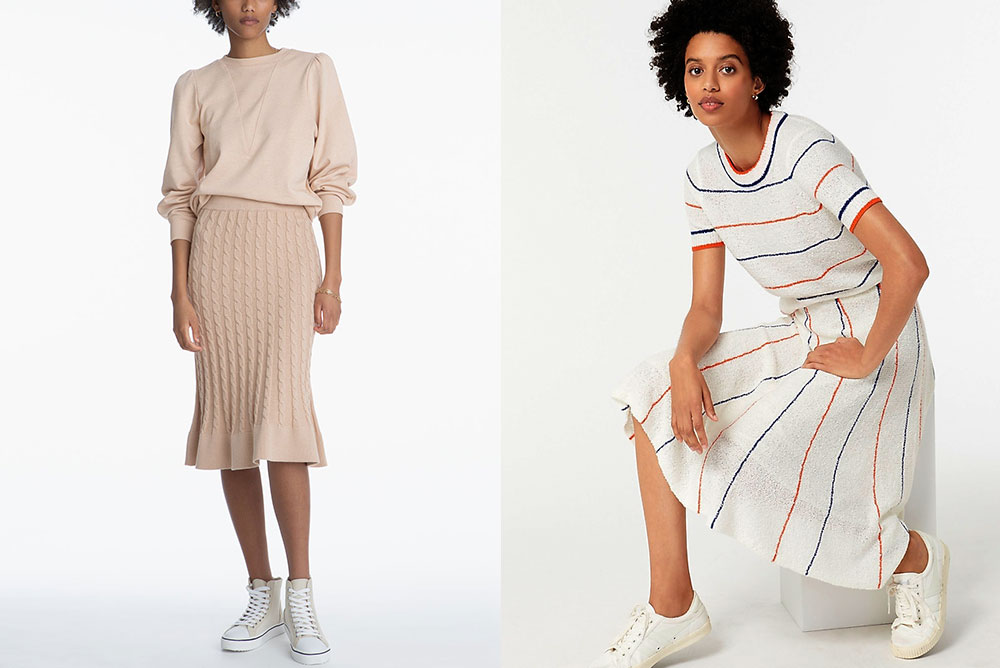
LEFT: What to wear when you want to look coordinated but feel comfortable is 525 America’s cotton-blend, elastic-waist Cable Knit Midi Skirt ($118) and puff-shoulder top in a similar shade.
RIGHT: Who needs a suit when you can pull off a head-to-toe look with this cute Sweater Skirt in Stripe ($98) and short-sleeve matching top ($59). Both are from J. Crew.
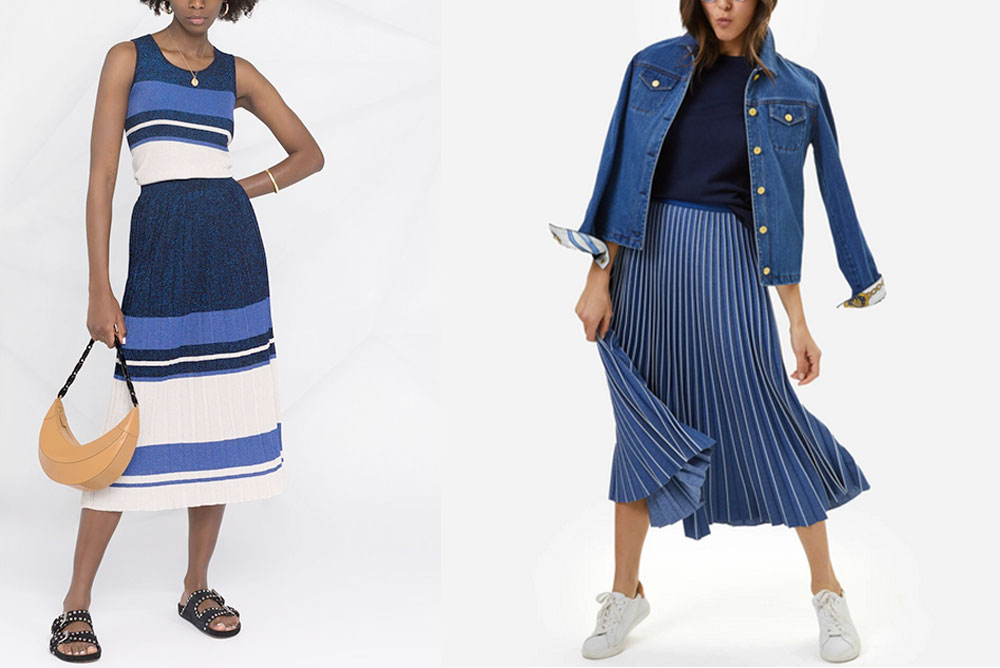
LEFT: Neutral colors mixed with muted metallics on cozy knitwear are in Modena, Italy-based Twinset’s wheelhouse. Pair the label’s Striped-Pattern Pleated Skirt ($203, Farfetch) with its coordinating striped metallic top ($143) to embrace that Mediterranean flair.
RIGHT: Denim puts a casual twist on J. McLaughlin’s pleated Paolo Midi Skirt ($168). Wear with an oversized sweater for cool evenings.
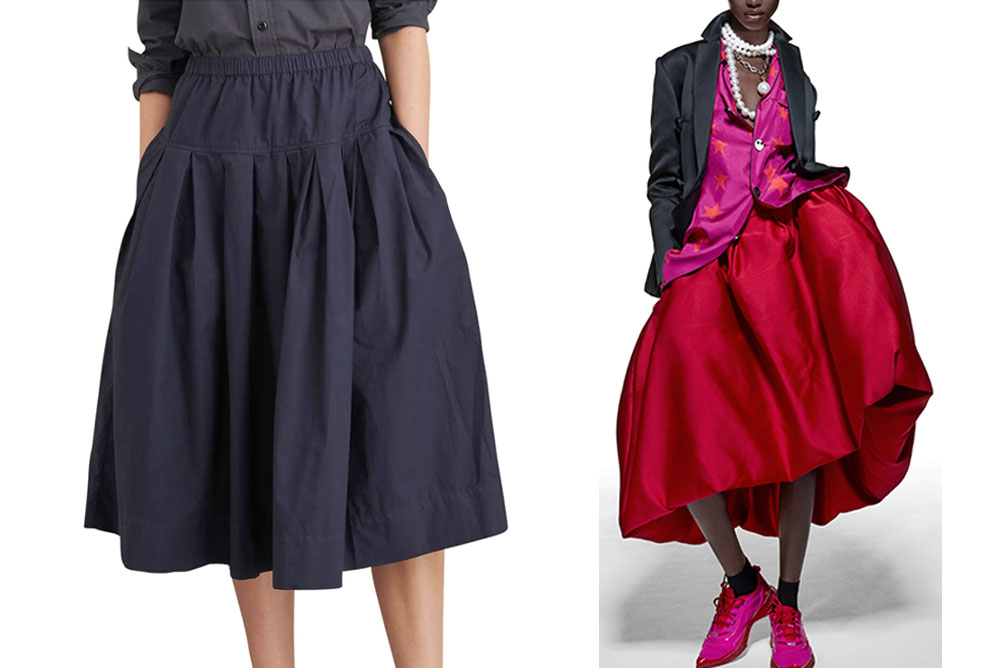
LEFT: As if this swingy Pleated Skirt from Alex Mill ($98, Hampden) with elastic waistband and perfect below-the-knee length weren’t already so wearable, it has pockets, too.
RIGHT: The death of designer Alber Elbaz, known for his stints at Lanvin and Saint Laurent, even shook the not-too-sympathetic-to-anything fashion world. Created for “women of our times” is how he described his just-launched, newest venture, AZ factory. The idea behind pieces such as this draped Duchesse Balloon Skirt ($1,275, Farfetch)—note the practical side pockets— is that it’s meant to be combined with other separates in the line like silk pajama tops, bodysuits and tights to customize your look and easily switch back and forth from laidback to luxe.
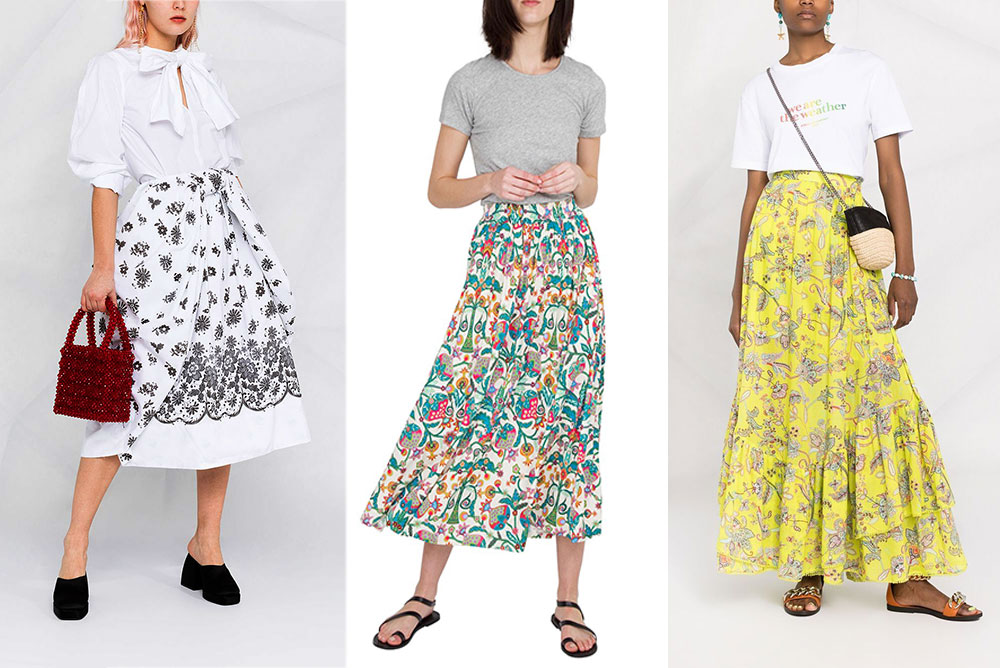
LEFT: It’s all in the mix for Simone Rocha, whose design mission is to create beautiful, layered and adorned as well as comfortable clothing. Except for the adornment part (pearls are her embellishment of choice), this floral printed, cotton Bow Front Skirt ($1,080, Farfetch) ticks off the boxes. You could wear it to the White House, say, if you were invited for lunch, or if you change the blouse shown above to a T-shirt or V-neck sweater and swap sneakers for those black mules, to a backyard barbecue.
CENTER: This easy-fitting, pull-on Tree of Life skirt ($435, Ann Mashburn) with a flowy A-line shape and a stretchy elastic waist is from Milan-based La DoubleJ, which makes its skirts (and dresses) from reissued vintage fabrics.
RIGHT: Can’t you conjure a summer day at some Italian beach—or Jones Beach—just by looking at Twinset’s sunny and elegant Floral Print Cotton Skirt ($339, Farfetch)?
By Janet Kelly and Nancy McKeon
MAY 9 is now 11 days away. But for weeks, we’ve been inundated—our inboxes flooded with suggestions about what to give Mom on her special day. Silk pillowcases, perfume and bouquets of flowers are fine and dandy, of course. However, we decided to go looking beyond the same old, same old for fresh ways to tell Mom how much she rocks our world.

LEFT: Phalaenopsis orchids are lovely and if anyone wants to give me one, I’d be most grateful. But a Miltonia orchid, well, that’s a sit-up-and-take-notice gift for your mother, daughter, niece, best girlfriend—you get the idea. Often called pansy orchids because they look a lot like garden pansies, they’re descended from wild orchids found in the forests of the Andes Mountains. The Rouge ‘Claf Plum’ Live Orchid Plant ($45, Etsy) will produce gorgeous red blooms with white outlines and accents on the petals. Did we mention it’s also quite fragrant??
RIGHT: Watering the garden is not the hard part; in fact, it can be a fine time to meditate or just daydream. What’s not nearly as enjoyable is rounding up the hose in a neat concentric circle so no one trips over it and breaks an ankle or something. Furthermore, even a perfectly wound hose lying around a patio or deck or balcony is not attractive. But that unsightliness can be contained. Frontgate’s Fleur de Lis Hose Pot ($159.20) has the look of Italian stone pottery (it’s actually crushed stone composite). It can store up to 125 feet of 5/8” garden hose, weighs 18 pounds, can stand up to the elements and has a drain hole to prevent standing water—mosquito hazard, you know.
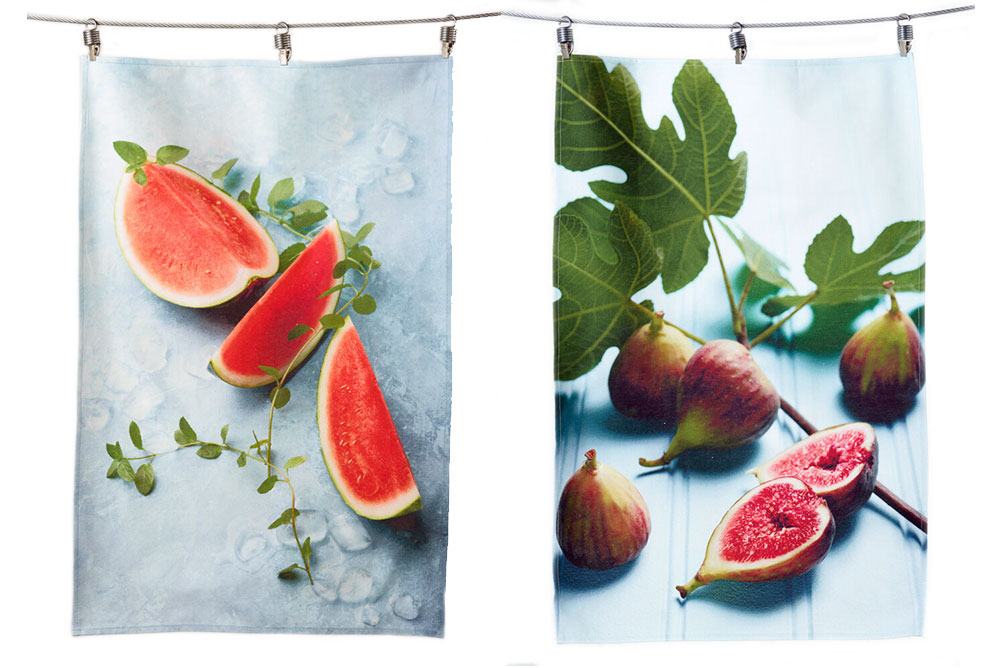 About five years ago or so, our favorite Washington DC photographer Renée Comet developed a line of cotton dish towels covered with her full-color food photos. Made of 100 percent cotton and manufactured in the USA, these delicious-looking textiles are meant to be shown off as well as merely used to dry dishes and glasses. Gift them to your favorite women. The Watermelon and the Figs tea towels are $22 each at Comet Cloth.
About five years ago or so, our favorite Washington DC photographer Renée Comet developed a line of cotton dish towels covered with her full-color food photos. Made of 100 percent cotton and manufactured in the USA, these delicious-looking textiles are meant to be shown off as well as merely used to dry dishes and glasses. Gift them to your favorite women. The Watermelon and the Figs tea towels are $22 each at Comet Cloth.
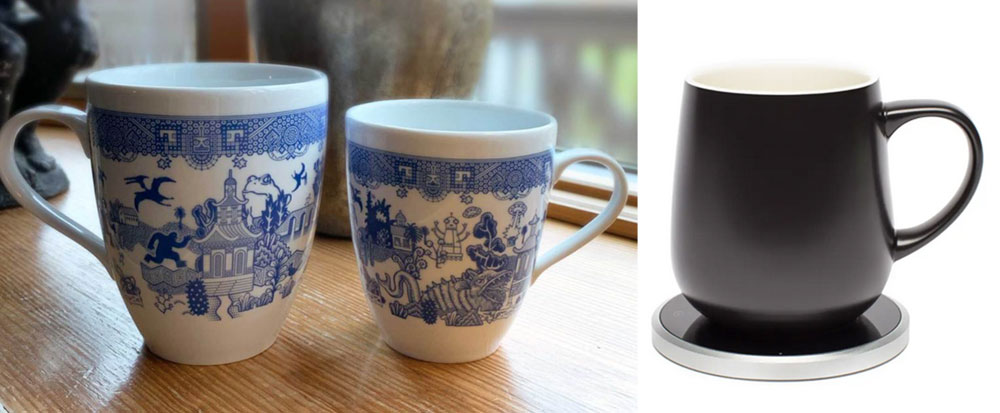
LEFT: At first glance, nothing to see here—very proper blue willow pattern mugs in standard 12-ounce and jumbo 20-ounce sizes. But, this is Don Moyer’s Calamityware, so that tidy Chinese garden temple scene is being bombarded by . . . everything bad: zombie poodles, evil robots, UFOs, giant frogs, pteradactyls, Bigfoot . . . and more! “Things Could Be Worse” porcelain mugs are a good way to make sure Mom is paying attention! A single 12-ounce mug is $19; a two-pack of the 20-ounce size is $45; a four-pack of the 12-ounce size is $54. All at the Calamityware site.
RIGHT: Does you mother love her morning cup of coffee but hate how quickly that must-have beverage cools down before even finishing that first cuppa? Sure, there’s the microwave, but this Ui Mug & Warmer Set ($75, Nordstrom) might be a better solution.The 12-ounce ceramic mug (dishwasher safe) comes with a special charger that uses magnetic induction energy to heat up the metallic layering on the cup’s bottom. It keeps the coffee toasty—around 135 degrees. And just in case your smartphone needs more juice, the warming base can charge it right up. The set includes mug, lid, charger and 12-volt power adaptor.
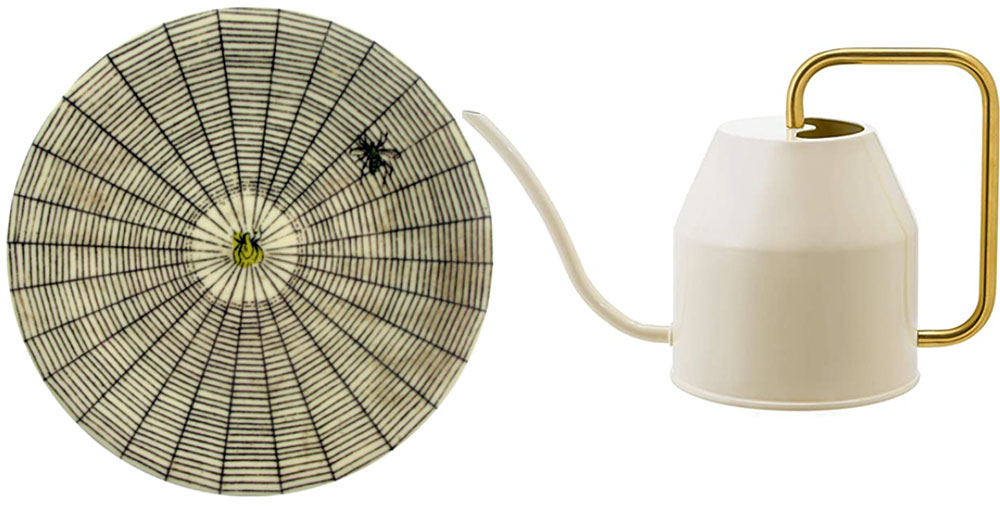
LEFT: John Derian’s glass découpage dishes can be pricy. But Derian, who definitely has a taste for the droll, also has a lighter (in price) side. His line of 7¼-inch dessert or salad plates in melamine are the perfect complement to this Covid year’s appetite for outdoor dining. Unbreakable, of course, and won’t break the bank at $8.50 each. Shown is Spider Web; plates are also available in several traditional faience patterns.
RIGHT: Sometimes—actually often—simple is best. Like this functional and decorative Ikea Vattenkrasse Watering Can, which works well for small, discrete areas. It’s $20 from Amazon.
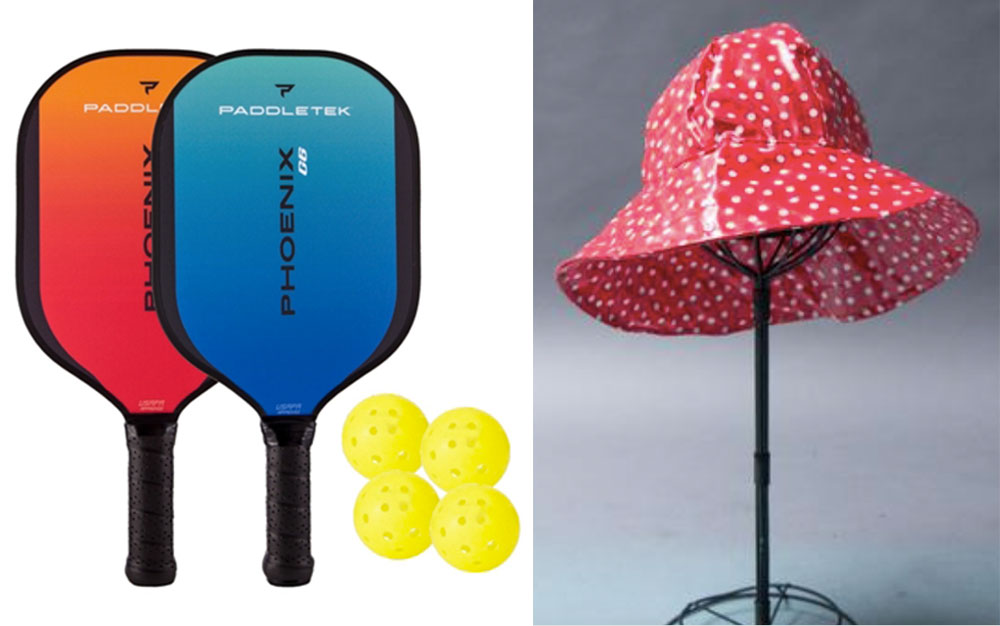
LEFT: When my hardcore tennis buddies started talking up Pickleball, and I noticed that the few courts at the park near my house were always full, it occurred to me to pay attention. My enthusiast friend recommended getting paddles from Paddletek but admitted choosing one was complicated. If you want to encourage Mom to join in the fun, here’s a way to begin: The Paddletek Phoenix G6 Composite Paddle Bundle ($119.99, Pickleball Central) comes with two paddles and four outdoor pickleballs in yellow. If you have a portable net or local court to visit, you’ll immediately be able to start a game. Tell us how it goes.
RIGHT: I like a few of things about this rain hat. For one thing, if it’s raining, I definitely need polka dots. Second, the brim is broad enough to keep all that wet from streaming down the back of my neck. Third, and possibly best of all, is that it comes in two sizes and has an interior elastic hatband that adjusts the fit and the Outside Designworks website instructed me on how to measure my head. All that for $45. Denise Dickens, the craftswoman in charge, also produces raincoats, ponchos, and other hats and accessories for men and women. Lined rain hats (the lightweight polka-dot version is unlined), also in a range of colors and prints, are $50.
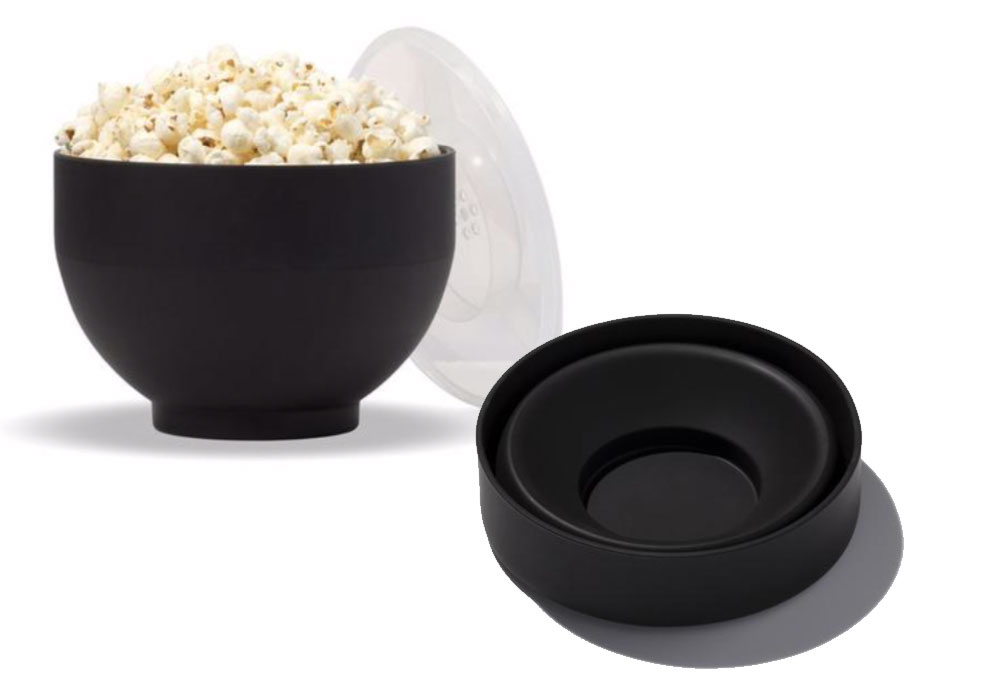
Five tablespoons of popping corn + 1 tablespoon of oil + a bit of salt + 3 minutes or so in the microwave oven = real old-fashioned popcorn minus the nasty synthetic-laden microwave bag and the dubious “movie theater taste.” This isn’t the only genius silicone popper out there, but I like the nod to minimalism in shape and color. And I love the fact that, post-popping, it squooshes down to a couple of inches in height and lets me stow it away in a drawer. The Popper, from W&P Design, is $20 at Nordstrom.
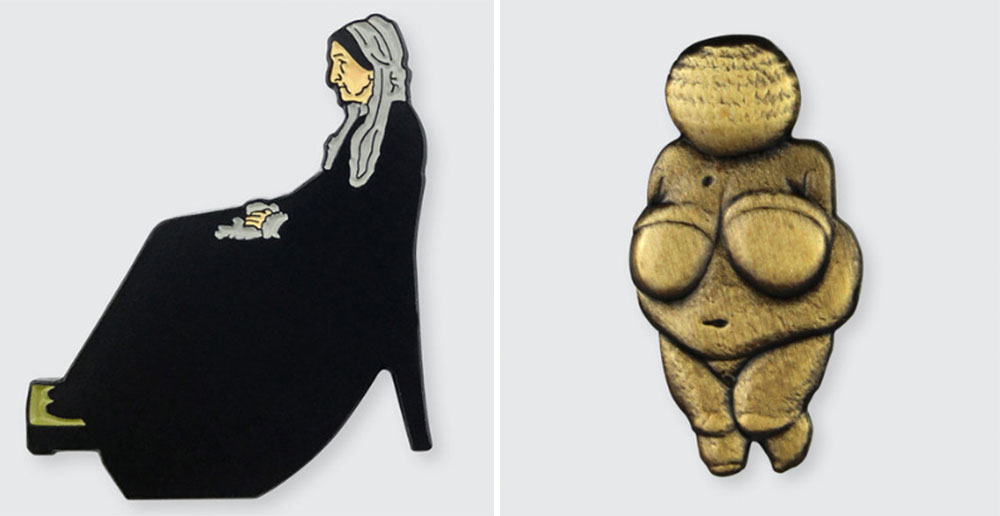
These little (about 1¼ inches tall) arty “soft enamel” lapel pins aren’t just about mothers. There are plenty of other pins that riff on all sorts of art and sculpture. But c’mon, what better occasion to bestow “Whistler’s Mother” (left) on someone other than James McNeill Whistler’s mum? Or the Venus of Willendorf on just about any mom, this fabled prehistoric find thought to be quite the symbol of fertility. These and dozens more celebrations of art can be found at the Pin Museum, where the enamel Whistler is $10 and the 3-D Venus is $12.

The shimmer of real silk velvet when mated with embroidery makes pillows by Anke Drechsel totally Mom-worthy, in a range of colors and patterns. Left to right are “Mimosa II” in Orchid (12×12 inches, $192), “Mimosa” in Old Rose (12×12 inches, $236) and “William” in Sky Blue (20×20 inches, $404). All include the pillow insert. The pillows range in price up to about $600 and some come as large as 24×24 inches. They’re available at John Derian.
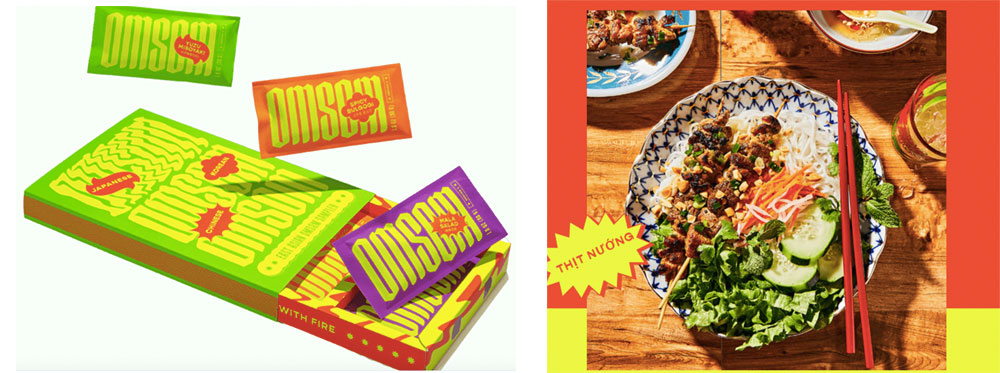
Wander over to Omsom.com and discover what your next chicken breast is going to be wearing for dinner. Seriously, the Asian flavors sealed in these “starter” packets deliver the zip that even big-city takeouts will find hard to replicate. The Pham sisters, Vanessa and Kim, raised by Vietnamese refugee parents, have collaborated with real-deal East Asian and Southeast Asian chefs to deliver the complexity of such treasures as Korean bulgogi, Thai larb and Vietnamese lemongrass BBQ plus some Chinese, Filipino and Japanese dishes. You can give Mom the Omsom Bundles for both East Asian and Southeast Asian dishes (two weeks’ worth of meals for two) for $55, or just tiptoe into the idea by buying a single-flavor 3-pack for $12 (each pack flavors two servings, so that’s still six meals). Mom just has to provide the pork or beef or tofu and veggies—or that chicken breast—that get to do the honors.
MyLittleBird often includes links to products we write about. Our editorial choices are made independently; nonetheless, a purchase made through such a link can sometimes result in MyLittleBird receiving a commission on the sale. We are also an Amazon Associate.
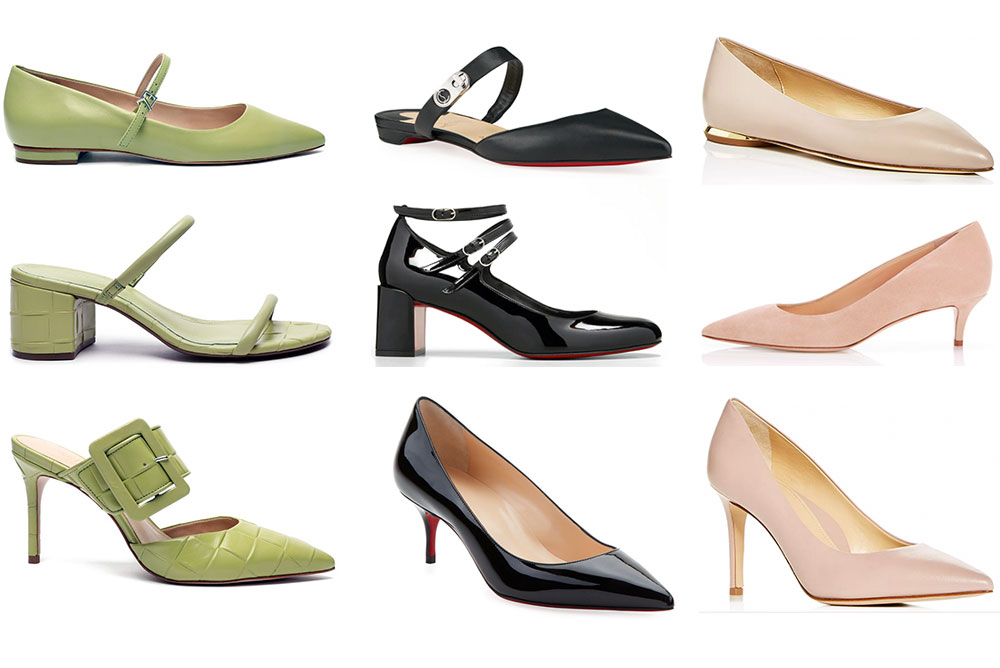
By Janet Kelly
MANY of us have spent the past year in slippers, nary a high heel in sight—nor an occasion to wear one. But even before the pandemic, women had been reassessing their relationship to heels in light of the casual-fashion trend. Remember Phoebe Philo looking so cool as she took a bow in her Adidas Stan Smith sneakers after her 2015 Celine show? The pandemic just accelerated the shift away from high heels.
However, as back-to-normal activities slowly resume, our wardrobes will also gradually transition—from stay-at-home sweatpants and sneakers to more structured but still forgiving and comfortable clothing and footwear.
For those who want to satisfy their lust for the look of status-y red soles, Pilgrim buckles and such, take note: You don’t have to risk life and limb in skyscraping stilettos (you will have to pay the same stratospheric prices, however). You can get your designer high without falling on your face with less lofty styles. Savvy, spendy brands like Christian Louboutin, Roger Vivier et al. have for years been showing the same styles in little kitten heels, block heels and flats as in their much more highly touted stilettos.
And there’s a newish (at least new to me) kid on the block—podiatrist and shoe designer Marion Parke, who wants women to wear high heels—all shoes—in a smarter way. Her styles are made to distribute weight evenly on the foot, emphasizing elegance over clunky. The goal is to bring wearability and fashion together.
Here’s a look at the highs and lows of some spring shoes.
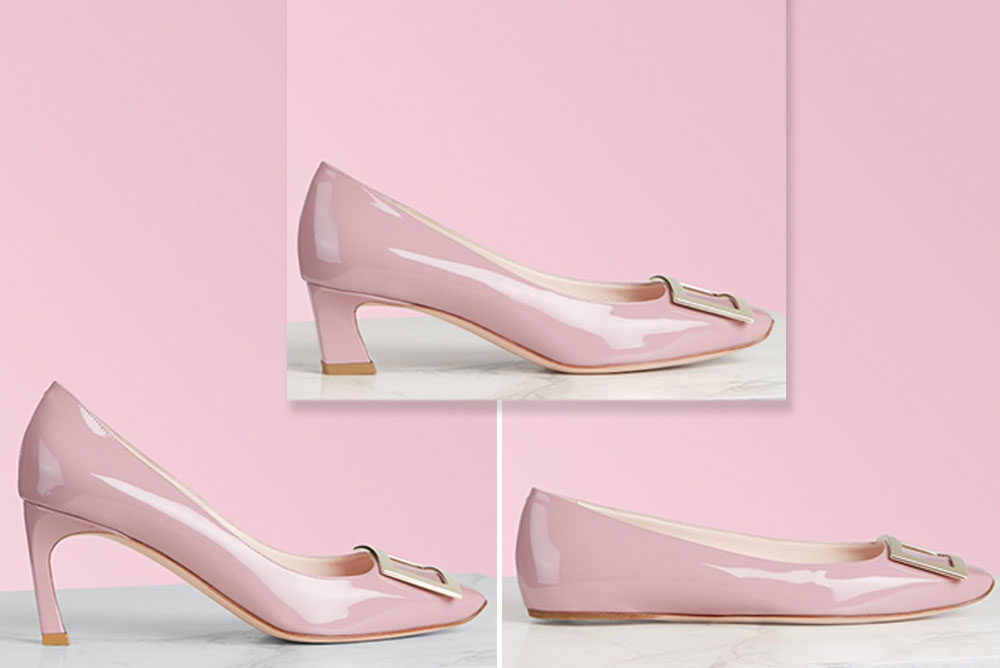
Everyone knows Roger Vivier for his classic Pilgrim buckle on lots of different heel heights. The Belle Vivier Metal Buckle Pumps with their “slanted geometric” heel go back to 1965. A reinterpretation of the Belle Vivier, the Trompette has a curved -shaped heel that slightly flares at the bottom. The 70mm Trompette Metal Buckle Pumps (left) are $775 as are the 45mm pumps (center). The ballerinas (right) are $725. We love all three in lilac, but the style also comes in nine other colors.
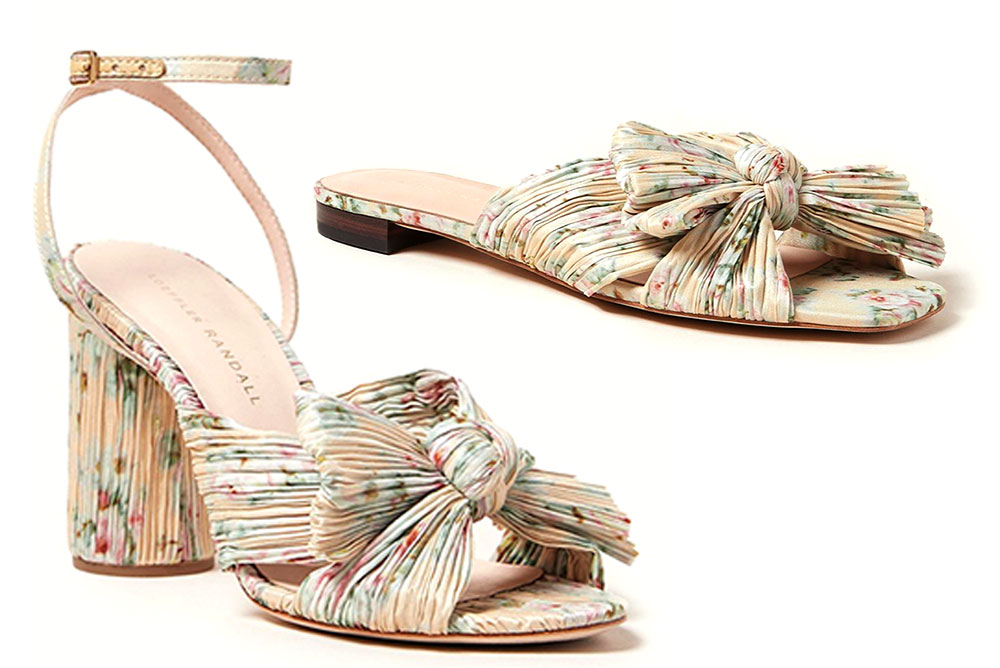
The fabric on Loeffler Randall’s open-toe Camellia Tan Floral Bow Heel ($395) goes through two different pleating machines to achieve the label’s signature “toothpick” pleat. The Camellia comes in a 3.5-inch block heel with adjustable buckle ankle strap. So retro and feminine. For more down-to-earth occasions, slip on the Daphne Tan Floral Bow Slide ($250).

Mid-pandemic, former Barneys fashion director Marina Larroudé launched the eponymous Larroudé, a footwear and accessories brand, “to bridge the gap between mouth-watering design and eye-watering prices.” A fun, flirty party shoe, Larroudé’s 3.8-inch stiletto Valerie High Heel Sandal in magenta satin ($295) comes with a wide toe box for comfort and a flared heel for added stability. But if you want just a little lift, the Valerie Mule in gold metallic leather ($275) is just as glam.

Christian Louboutin’s 55mm Kate Patent Red Sole Pumps ($695, Neiman Marcus) are just the right height to be a summer staple and a transition to wearing heels again for those who see that in their future. The unusual ankle strap keeps these Twist-Lock Napa Red Sole Ballerinas ($695, Neiman Marcus) from slipping off your feet. With its lower, block heel, for fall ’21, the king of stilettos introduced the patent leather Mary Jane Red Sole Pumps ($845, Bergdorf Goodman) as an alternative to his classic Kate.
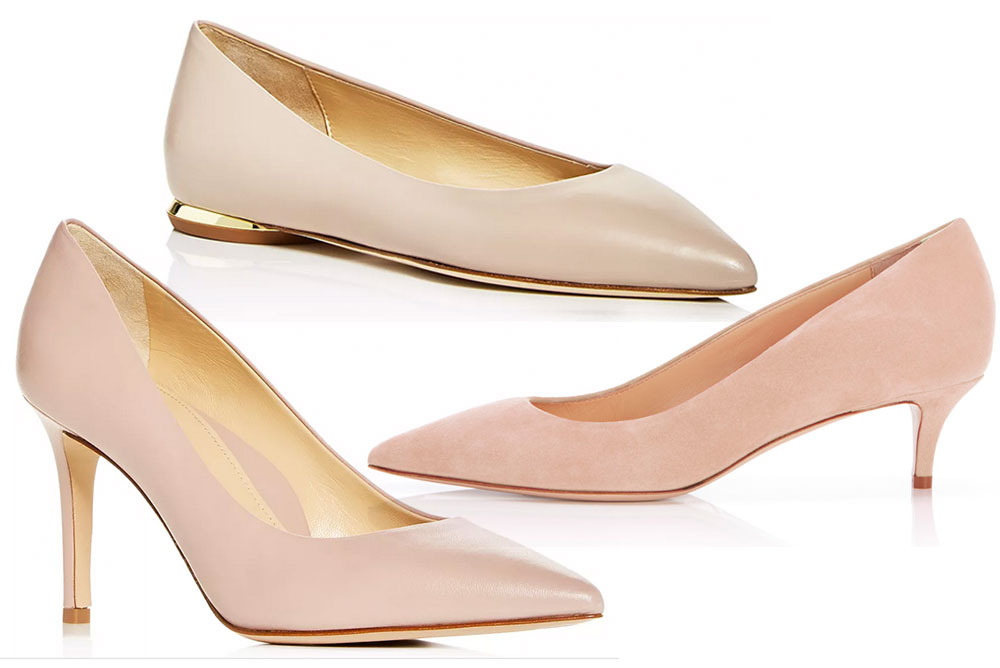
In Marion Parke‘s “Must Have” collection, heel heights range from the 85mm Nappa Leather Classic High Heel Pump ($495) to the 45mm Buff Suede Kitten Heel Pump ($495) and the Flat Pointed Toe Ballet Flats ($475, Bloomingdales). All are handmade in Italy, with a contoured insole, which is sculpted to follow the contour of the bottom of the foot. The key elements are arch support, a deep heel cup and added material along the outside for a more stable foot position.
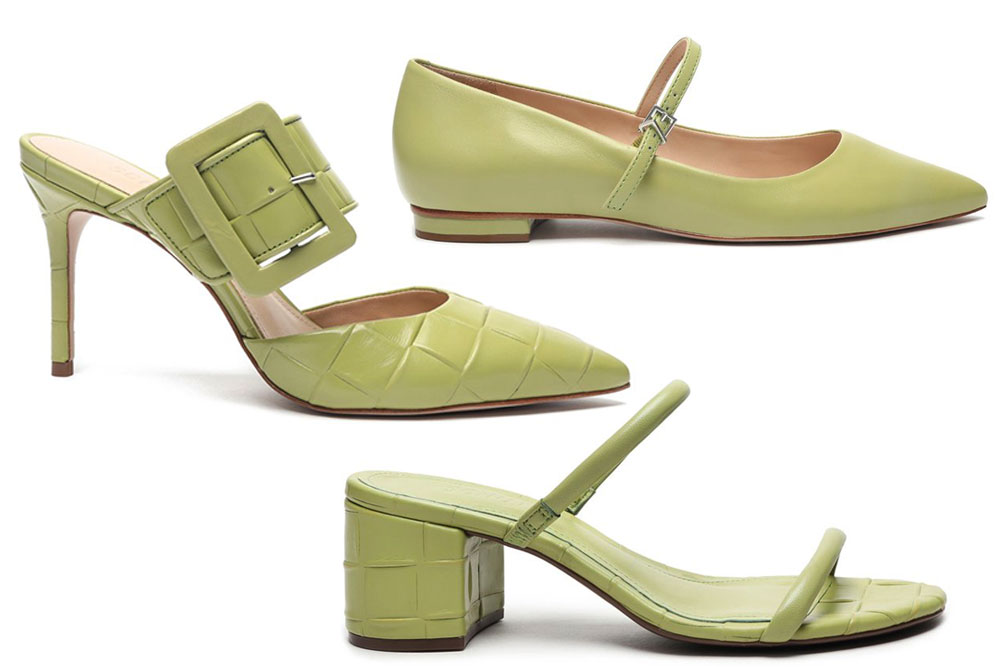
Brazil-based Schutz, owned by Alexandre Birman, is a less expensive alternative to his eponymous collection of polished shoes from chic kitten heels to block heels, stilettos, mules and flats. Some like it high. Schutz’s Hallie Buckled Leather Mule ($118) with a pointed toe and stiletto heel can be dressed up or down. The Ray Leather Mule ($98) with its thin straps nicely balances the bulk of the block heel. The Sunny Leather Flat ($98) is an all-occasion shoe in the color of spring.
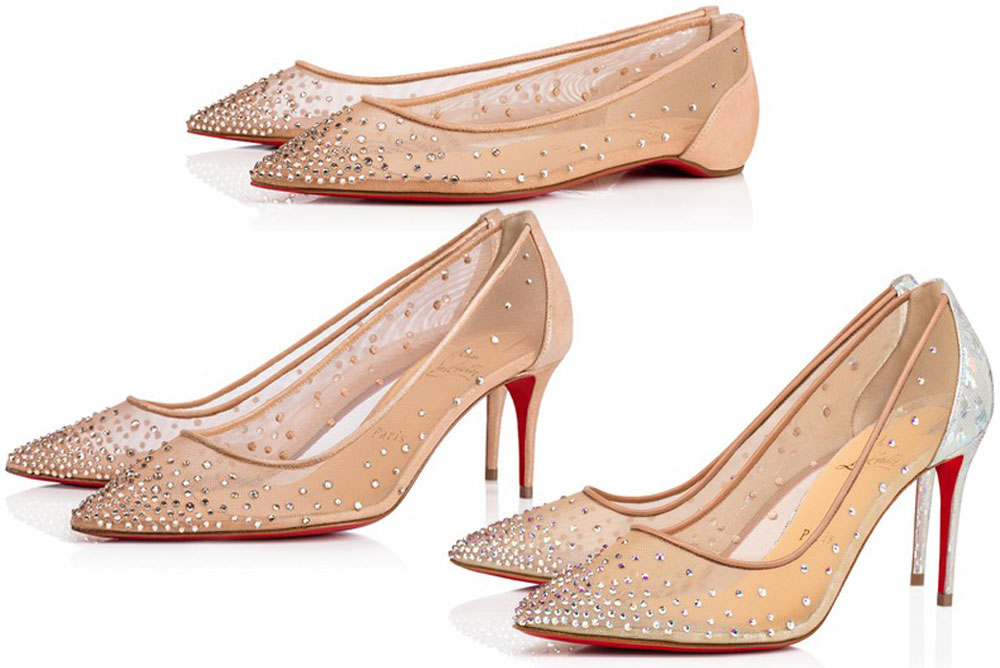
When you’re invited to your next ball, never mind the tiara. Instead put the focus on your feet with a pair of Louboutin’s Follies Strass shoes in transparent mesh sprinkled with sparkling rhinestones. Christian Louboutin’s Follies Strass heels come in 100mm ($1,195), 85mm ($1,195) and 70mm ($1,195) heights as well as a ballerina flat ($995). Cinderella shoes with red soles.
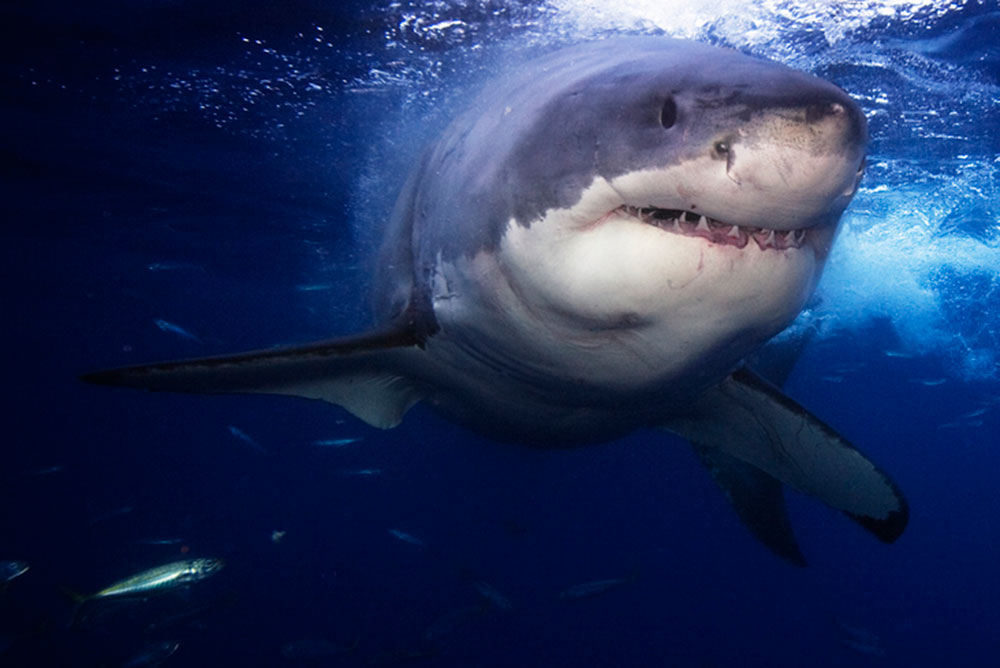
iStock
By Andrea Rouda
HERE AT the beach in Florida, with so many people frolicking in the waves, it’s hard not to think of the movie Jaws. At least it’s hard for me, as I am quite impressionable and the image of human legs dangling enticingly like tasty hors d’oeuvres from the shark’s point of view has stayed with me since I first saw the classic film in 1975. This keeps me from fully enjoying my time in the surf; getting eaten by a shark is the worst way I can think of to go.
I shared this thought with my husband, who disagreed and insisted that it would be, “a noble and honorable death, part of the grand scheme of life.” We then embarked on a conversation about what’s the worst way to die. Morbid, yes, but hey, it’s good to plan. Mitch thinks getting eaten by a predator is far superior to getting shot by a terrorist or suffering in a hospital ICU. “Predation is the way of the world,” says Mitch. And since we have been predators all our life, especially Mitch for whom no day is complete without eating some kind of animal, for us to become prey is “karmically fulfilling.”
I countered: Getting shot is over in a flash and likely painless, and in the hospital scenario at least you’re being cared for by professionals. The shark death is almost too gruesome to envision, yet annually in the United States there are 16 such attacks per year, with a fatality every two years.
Forget karma. When I die I want to be in one piece.
—Andrea Rouda blogs at The Daily Droid.